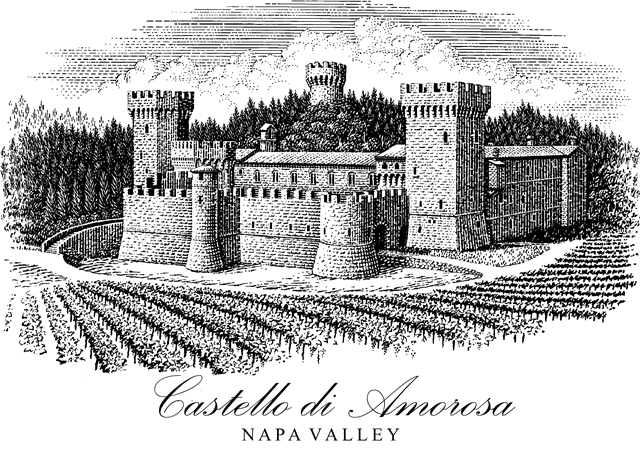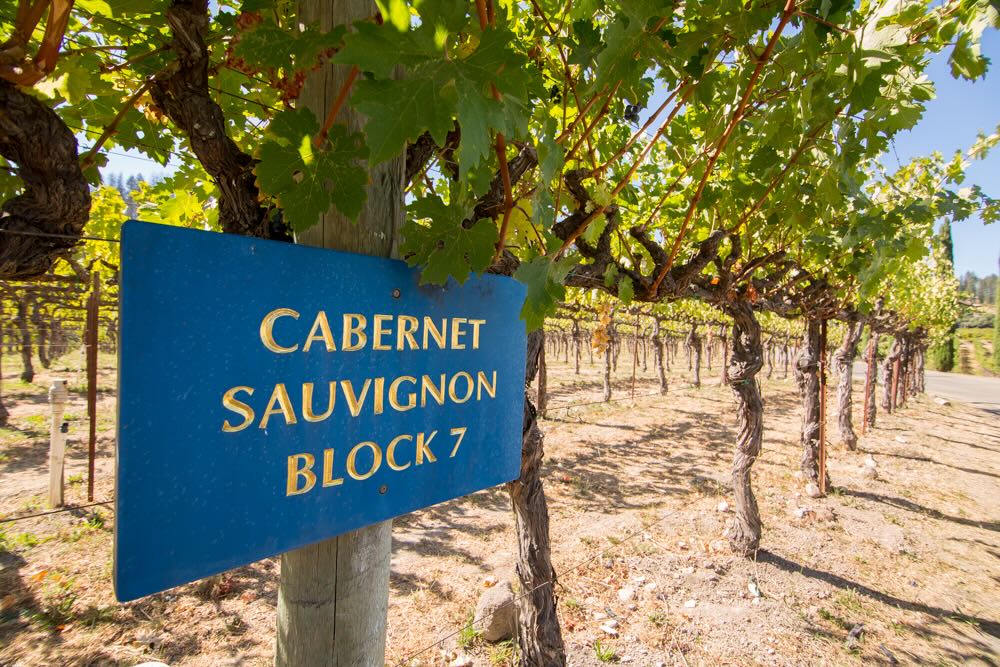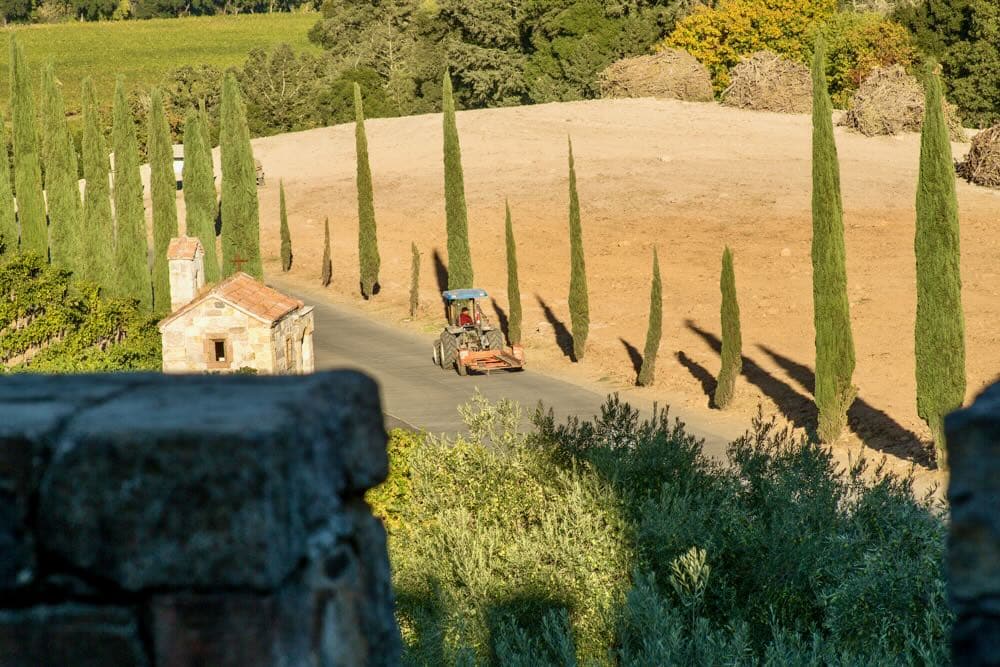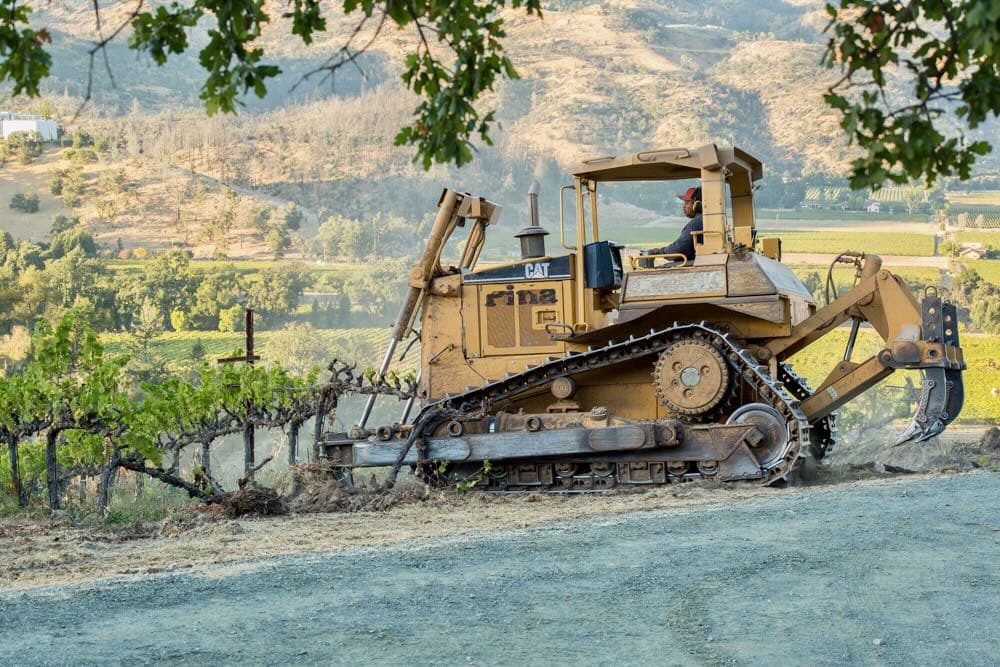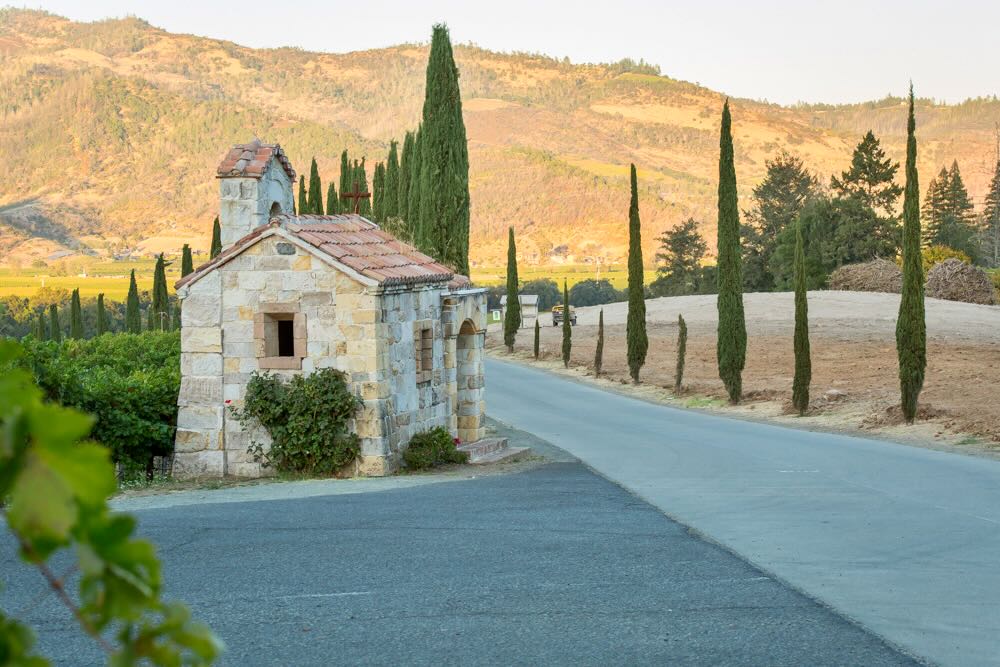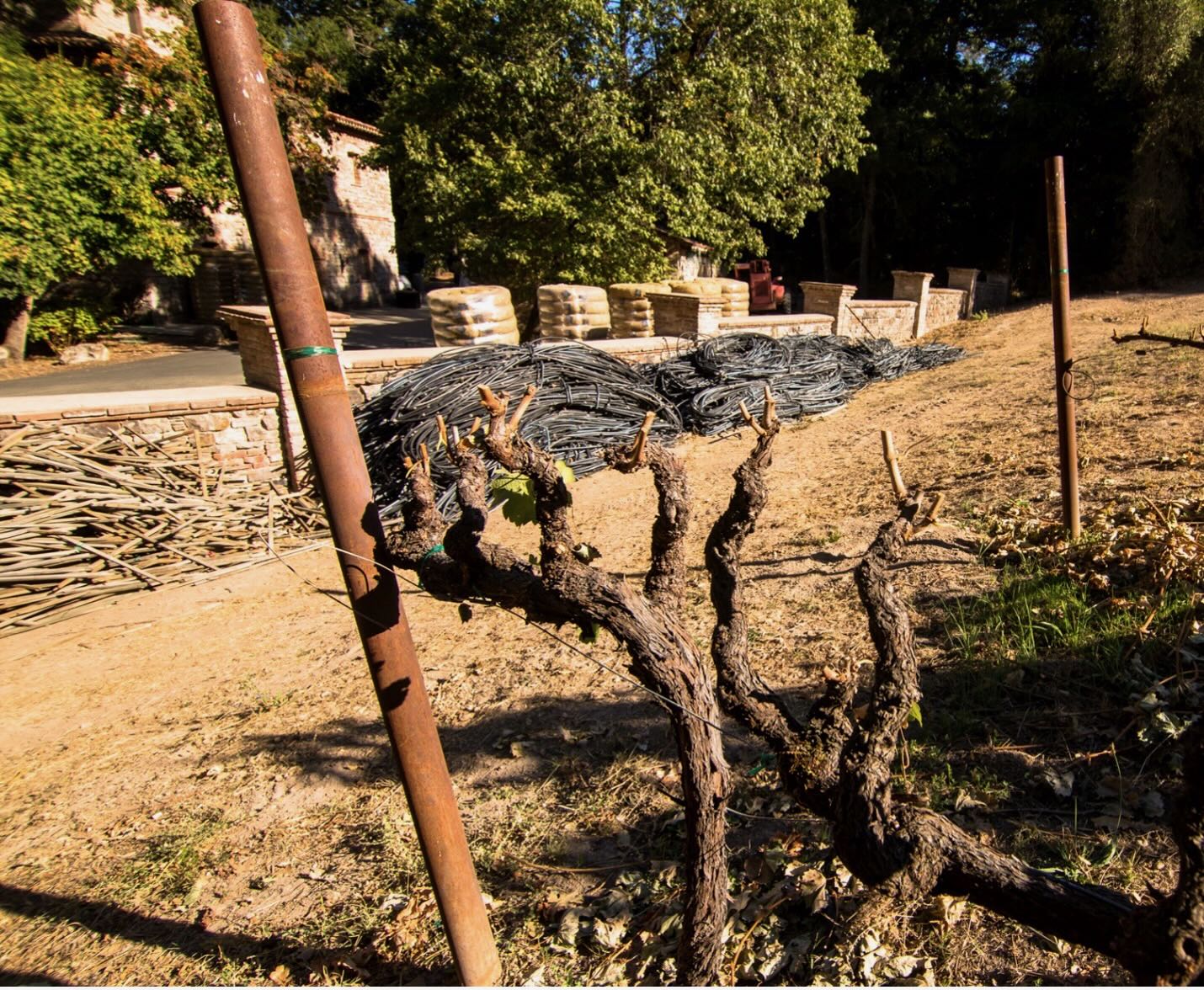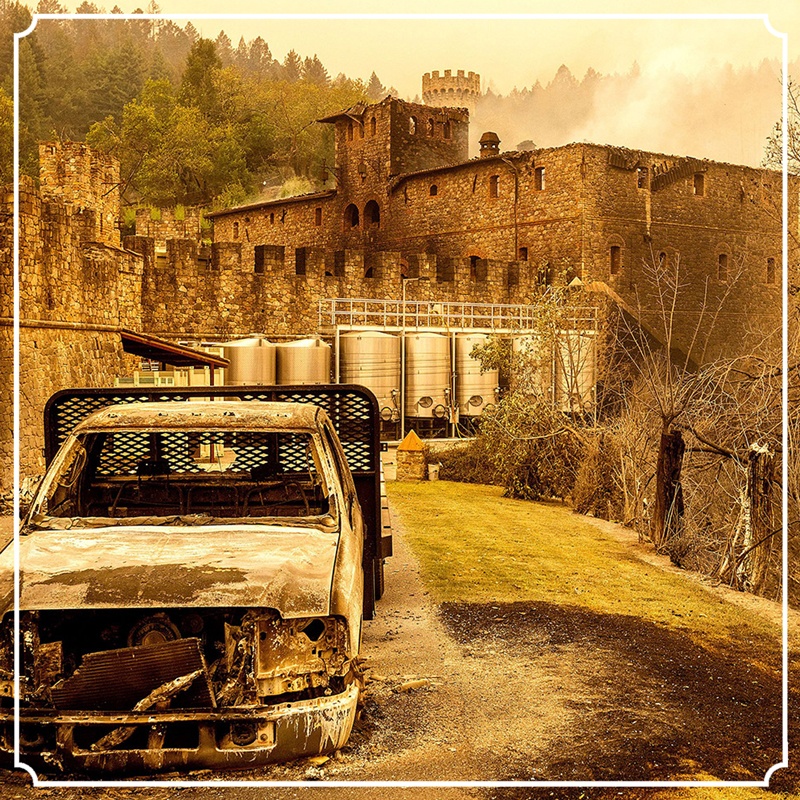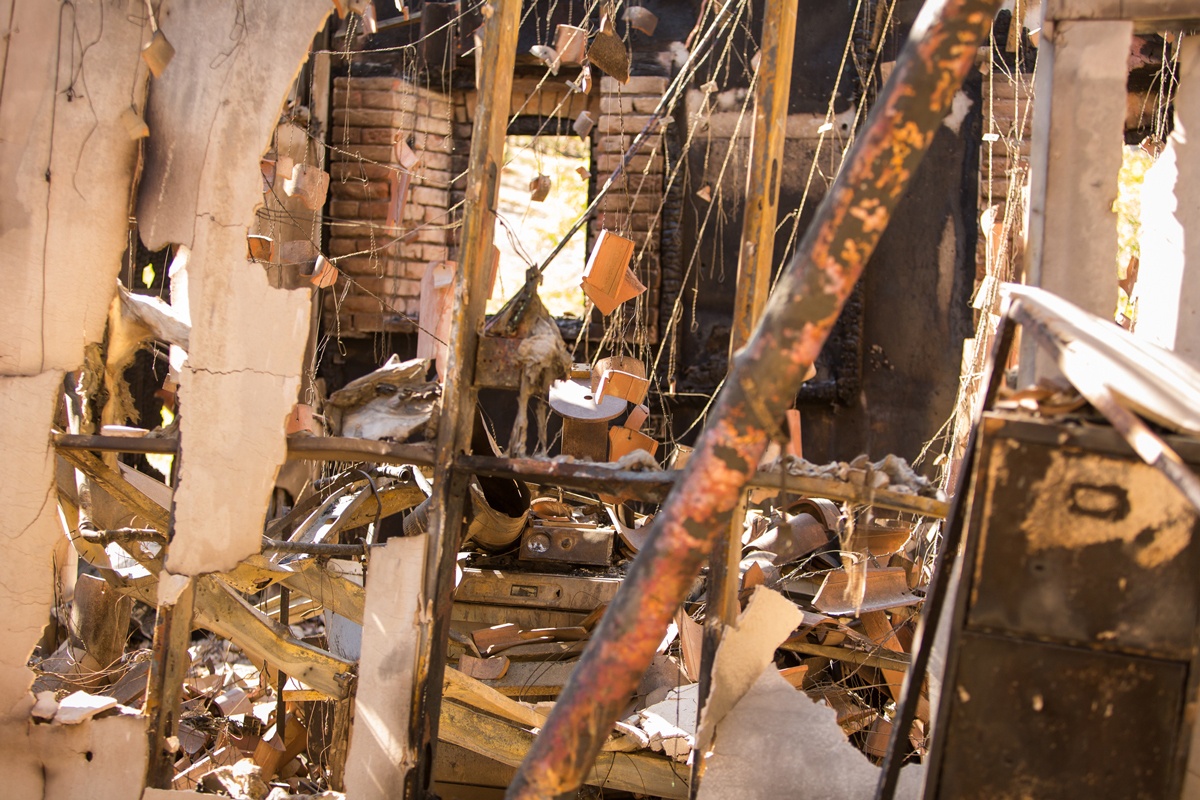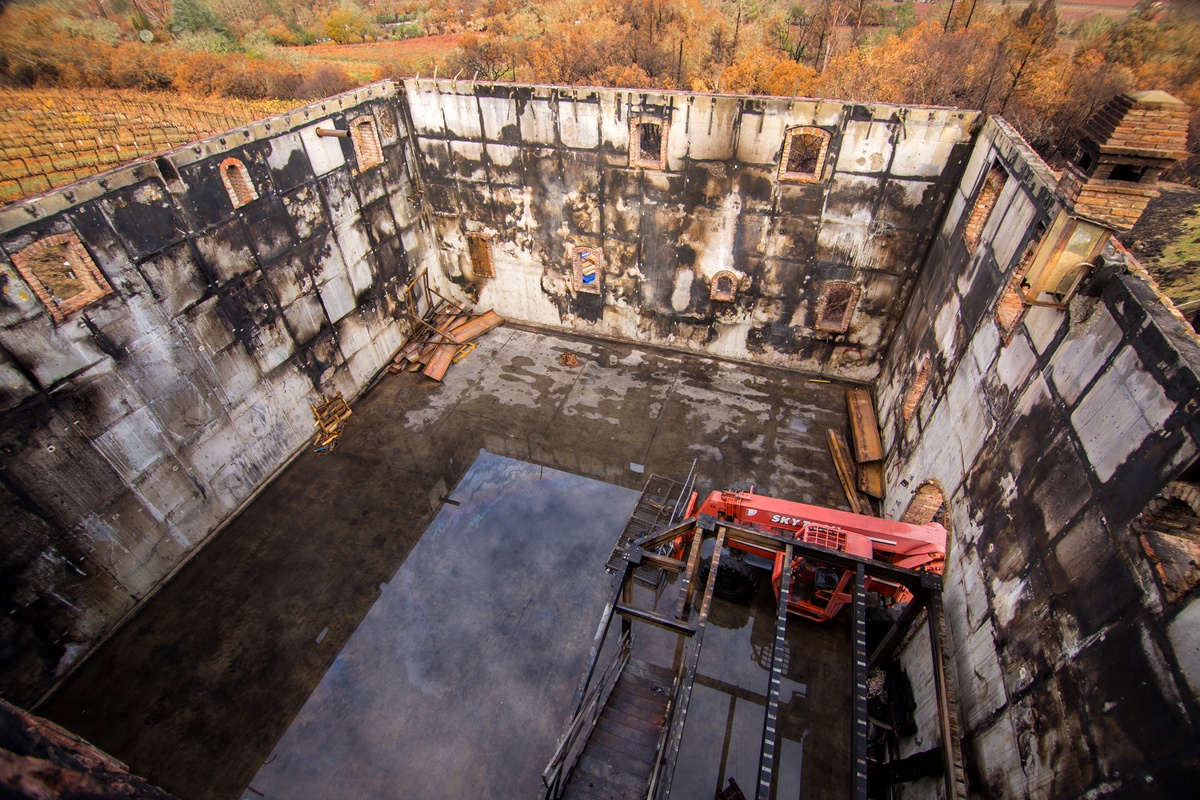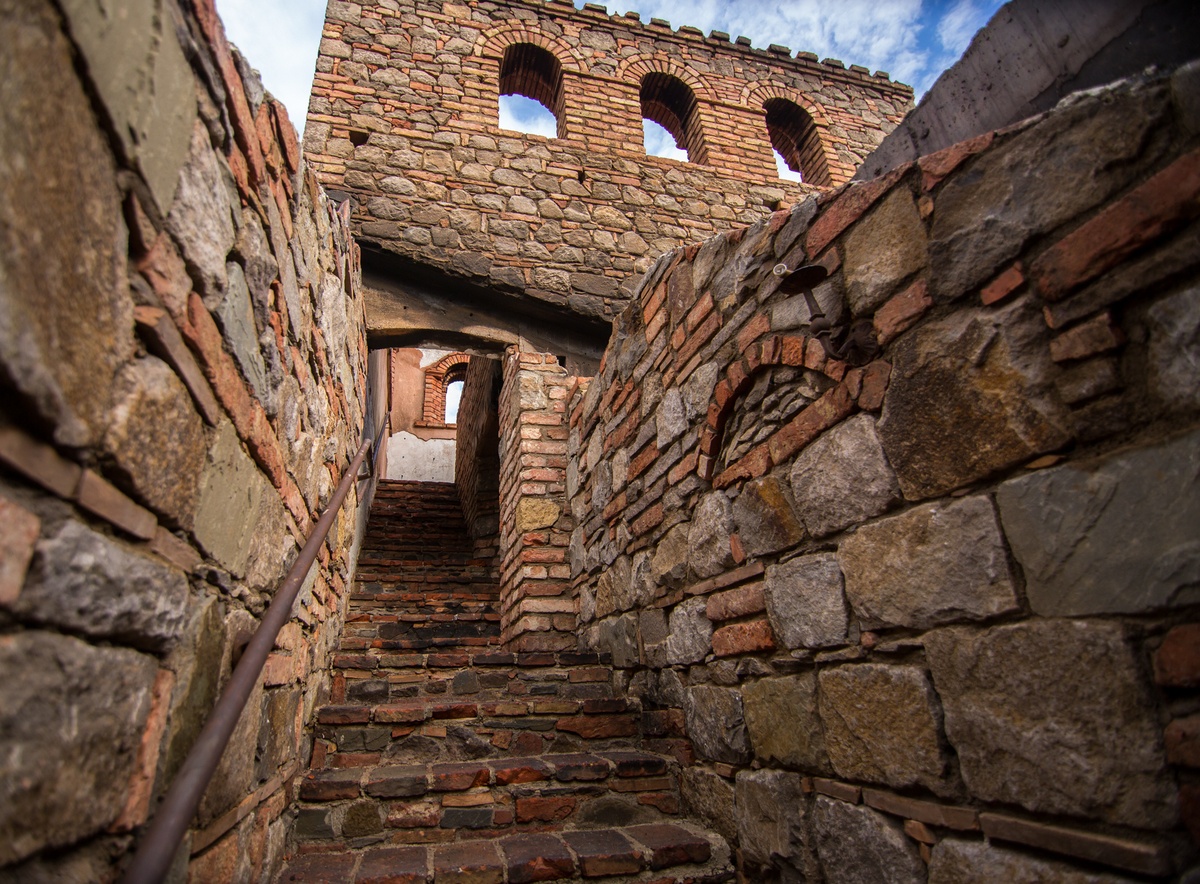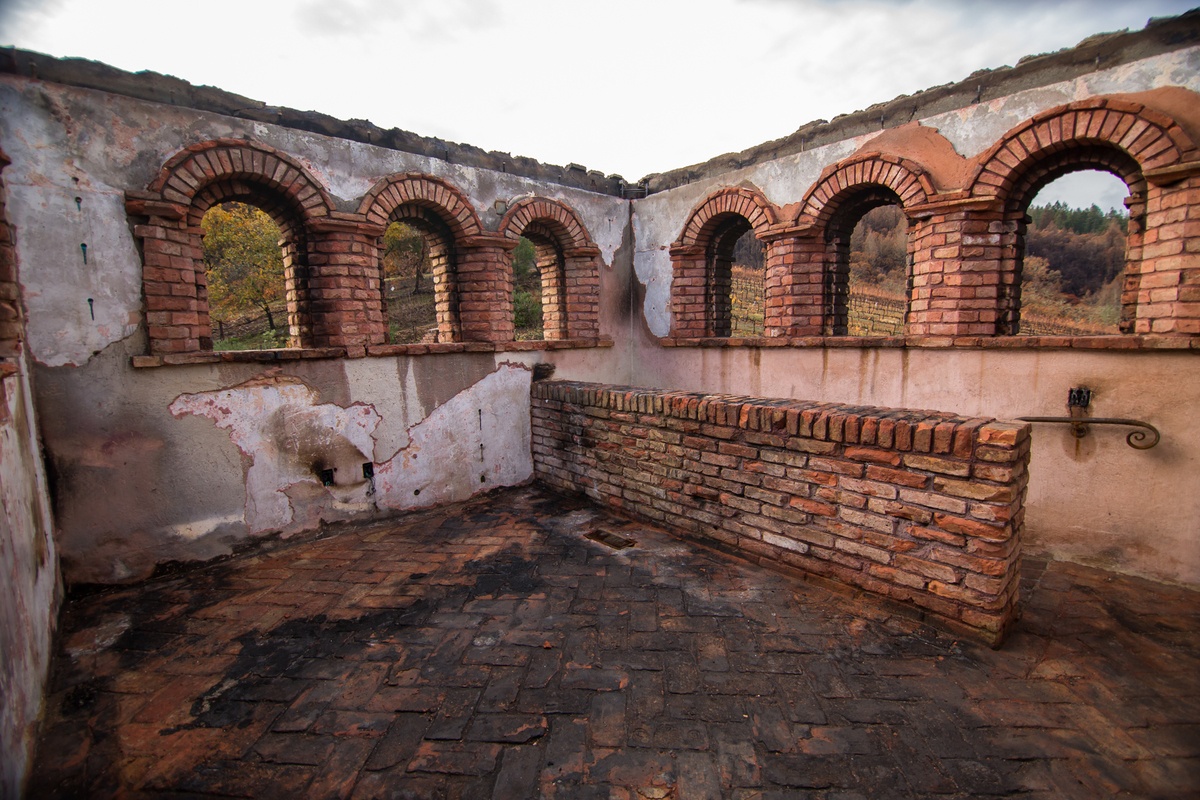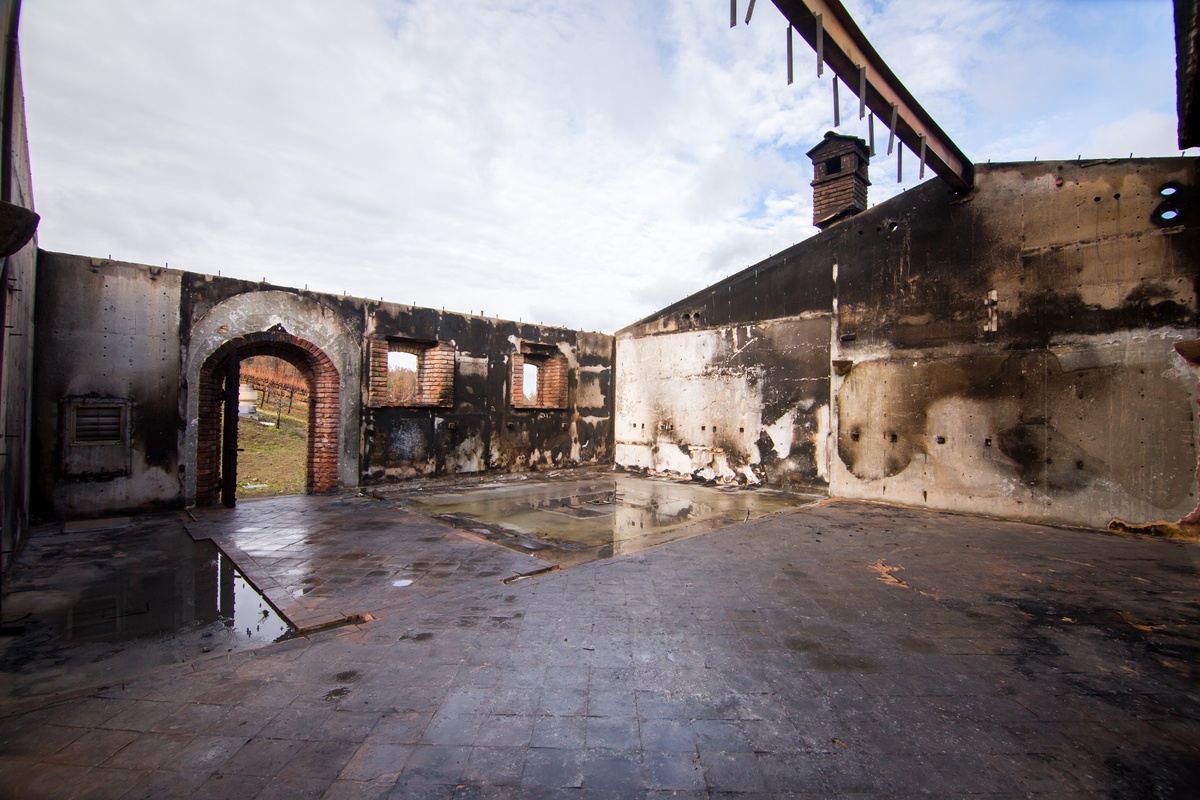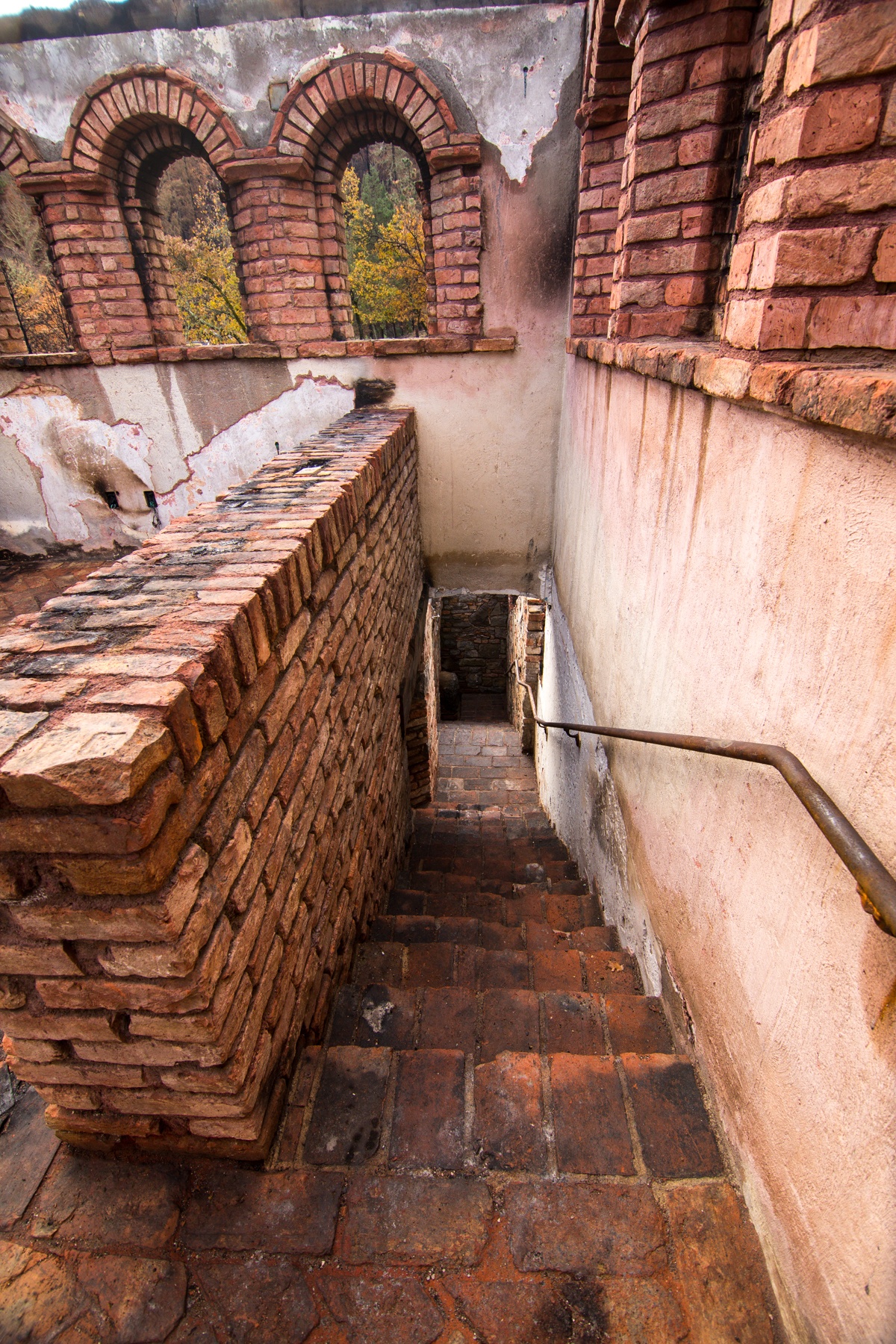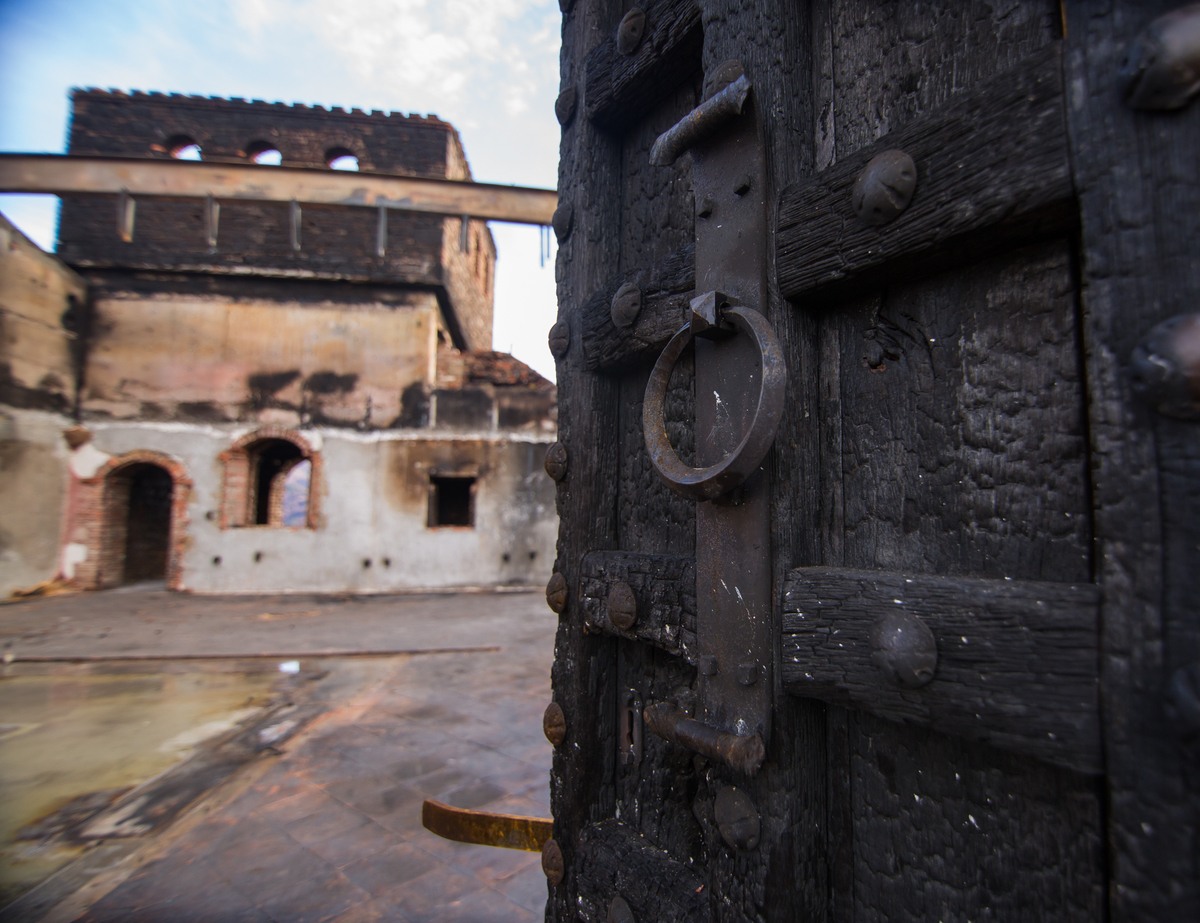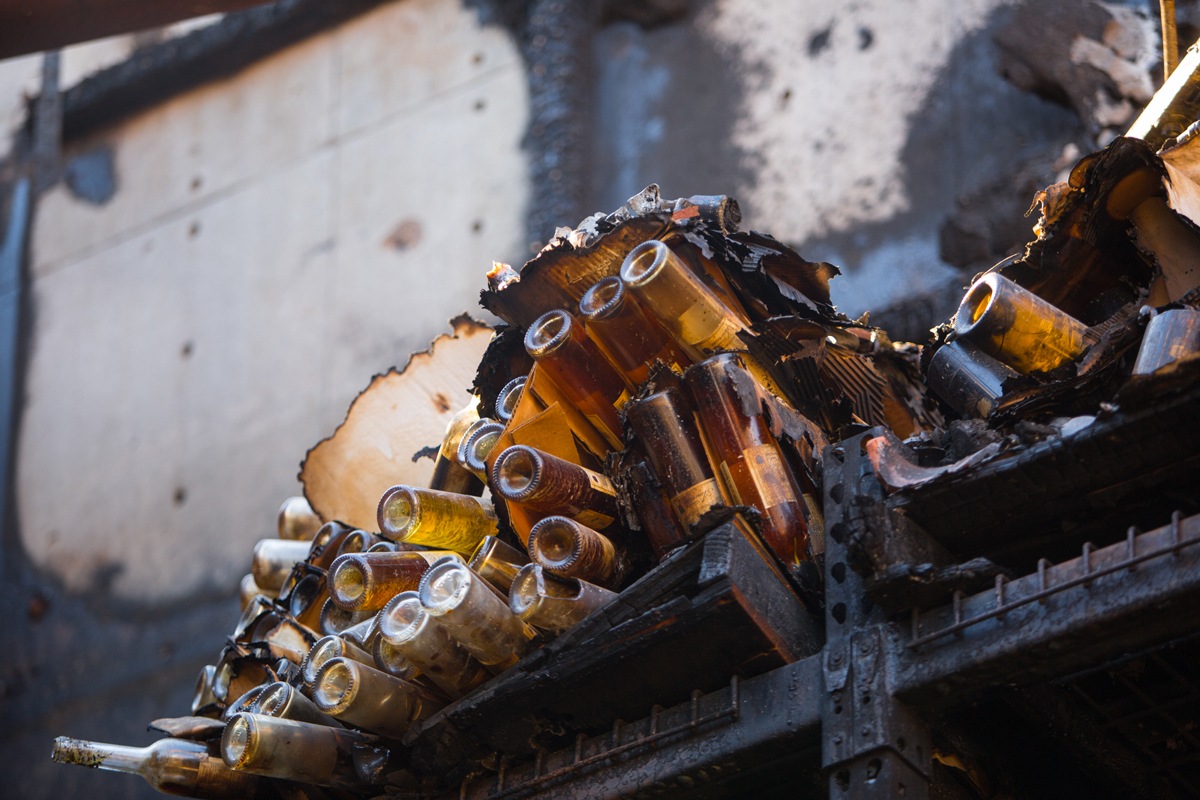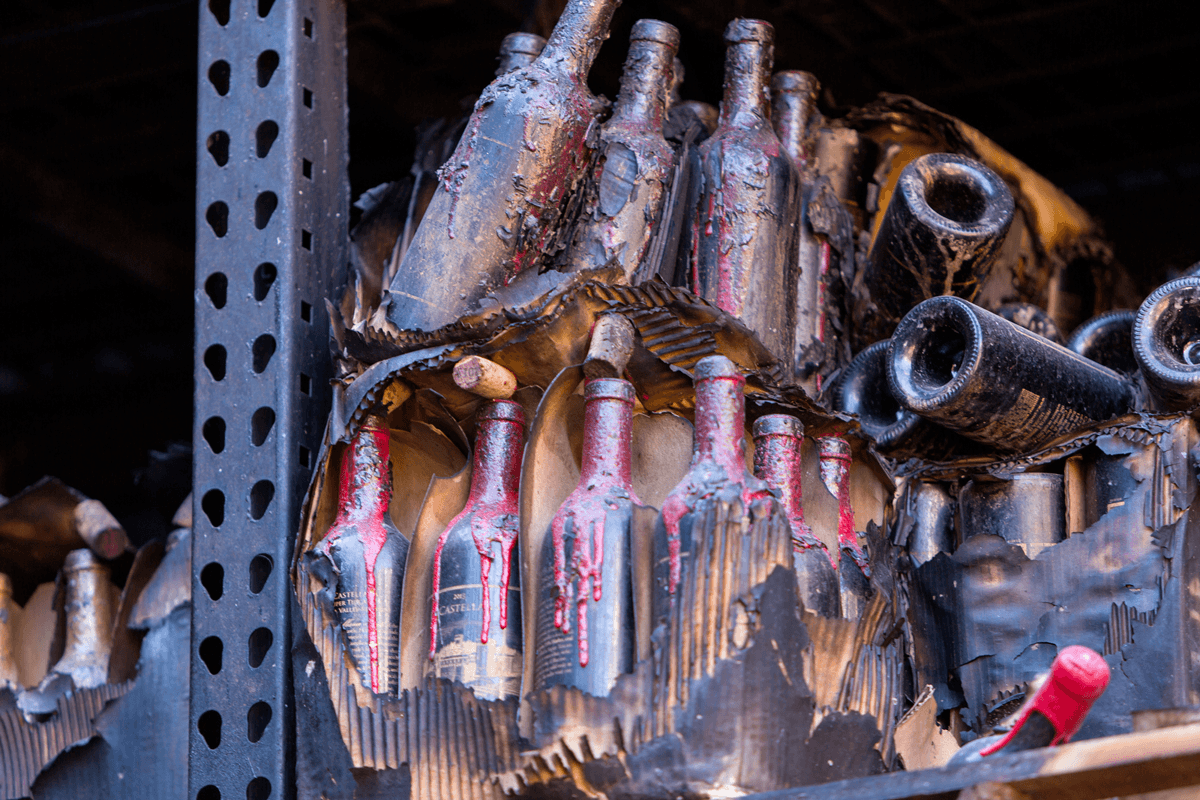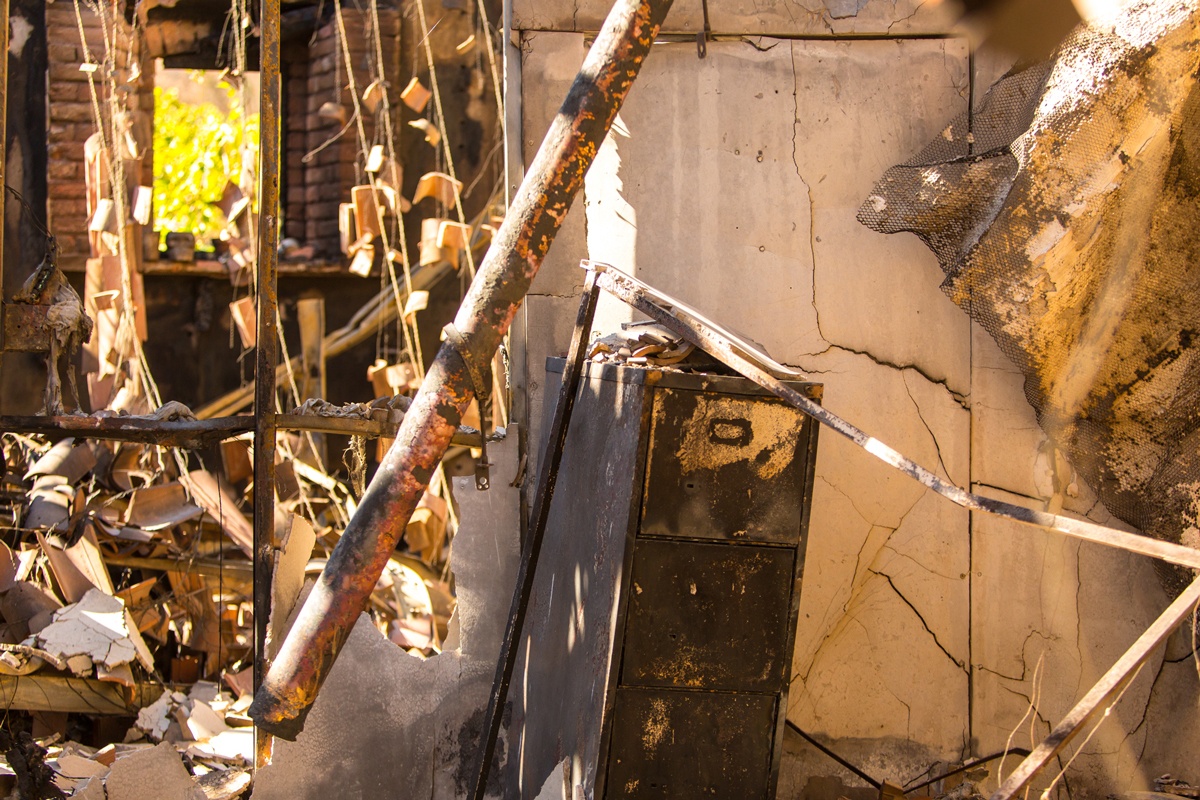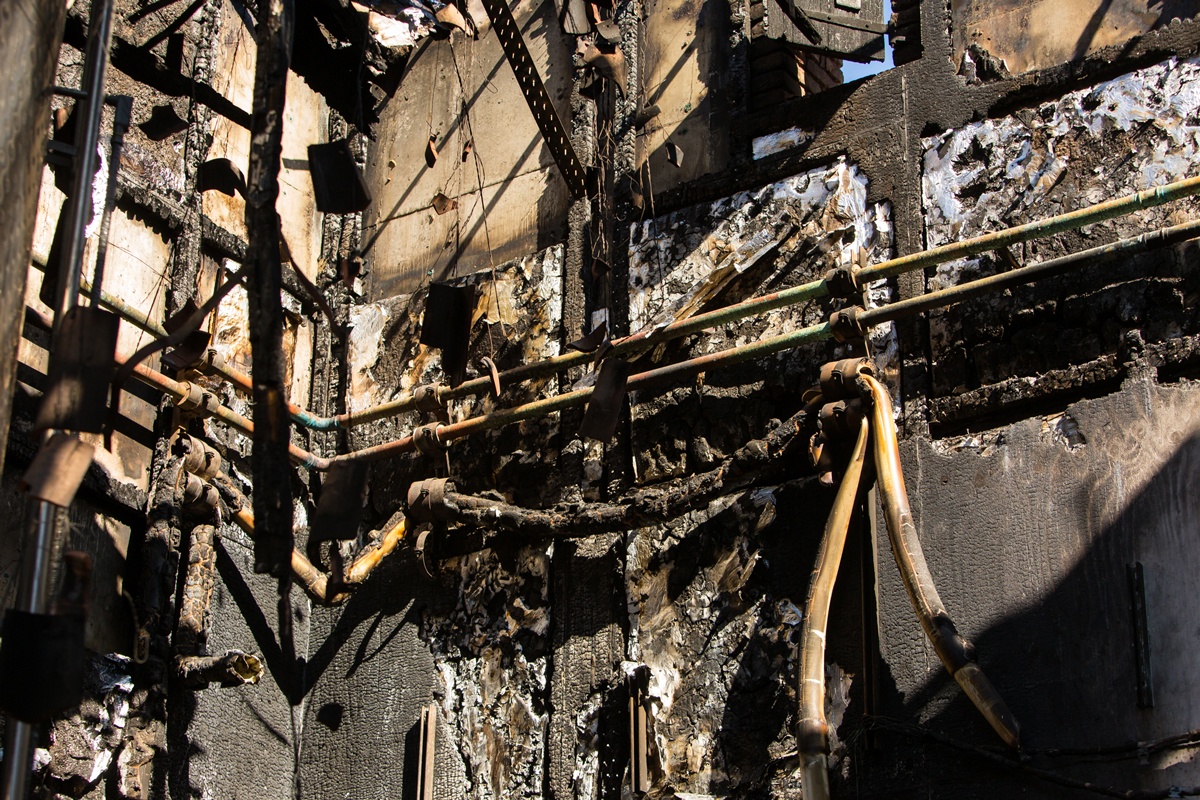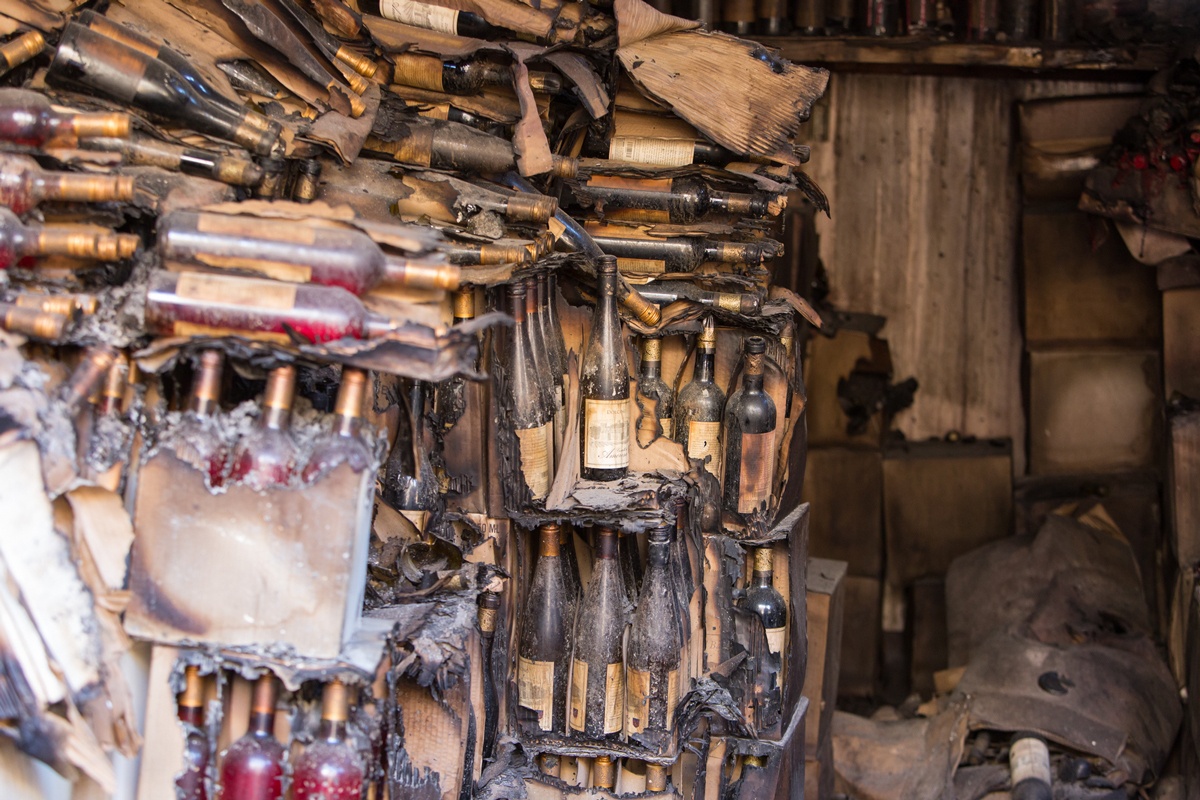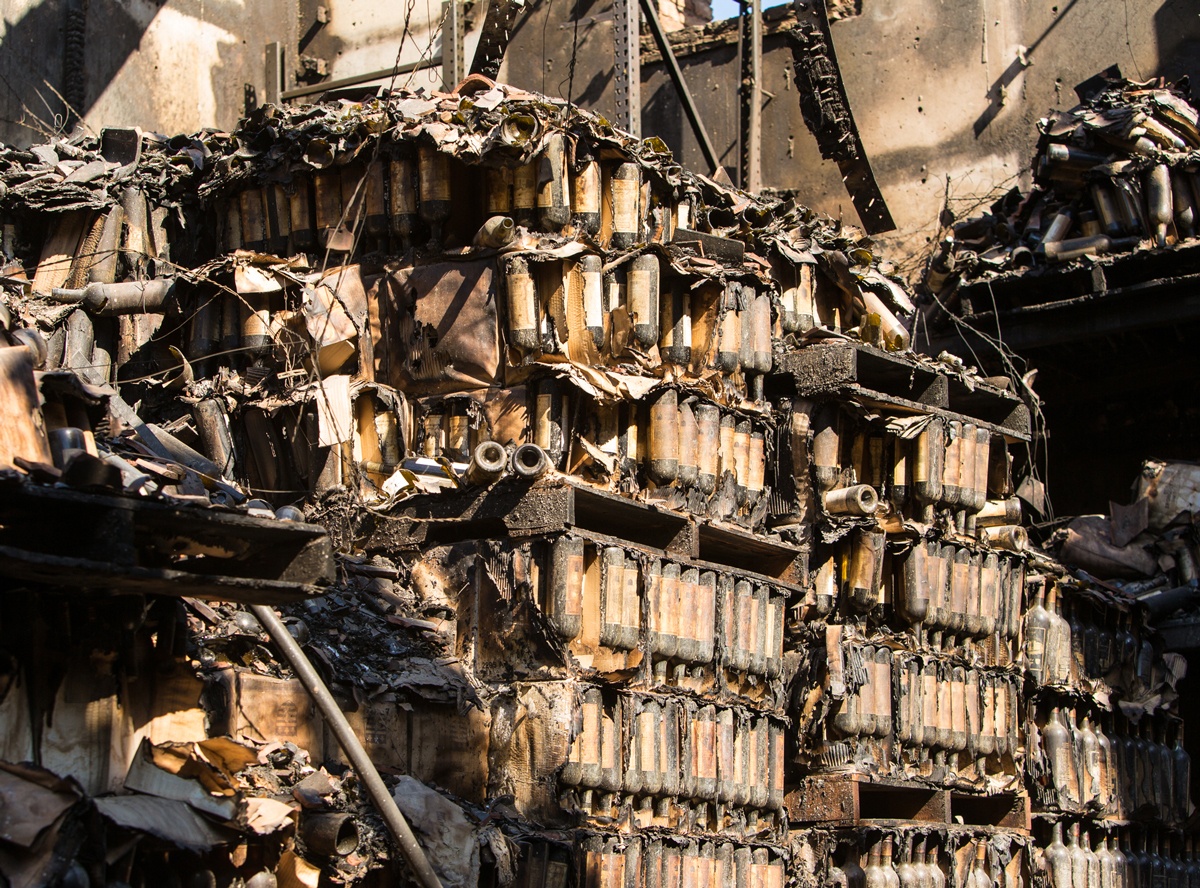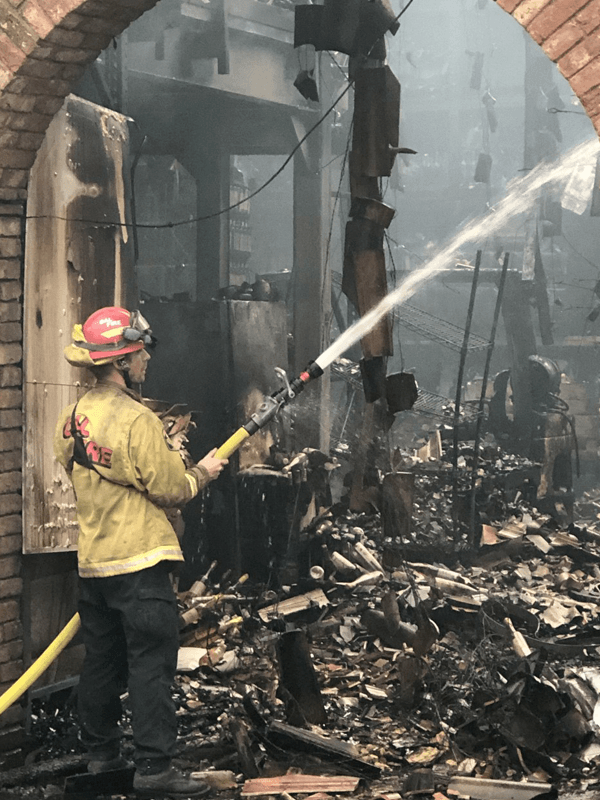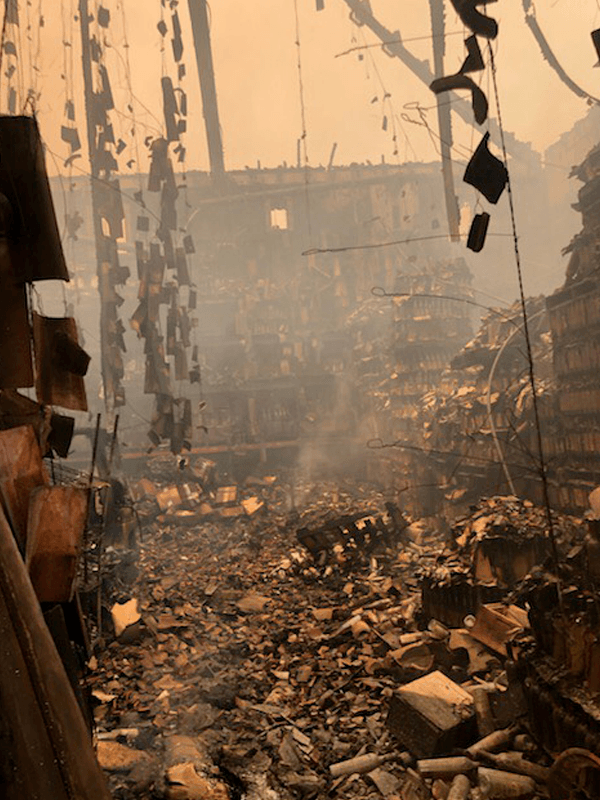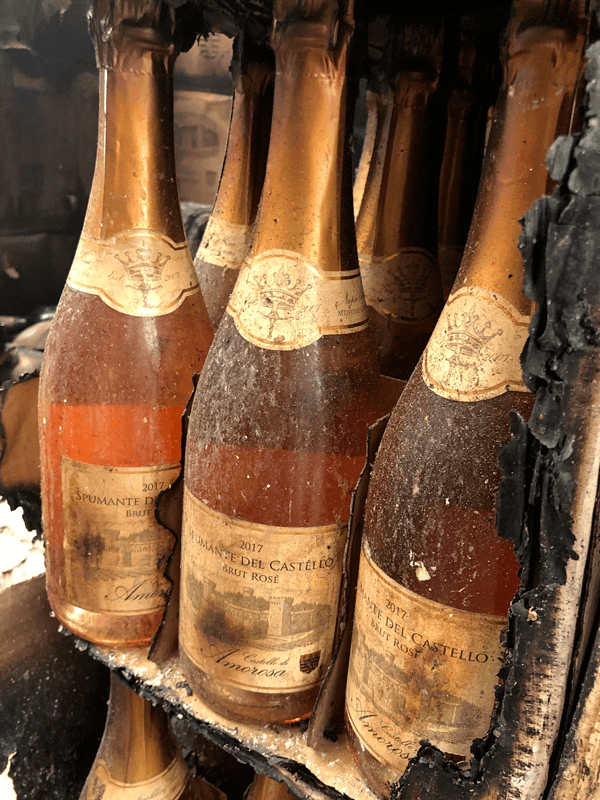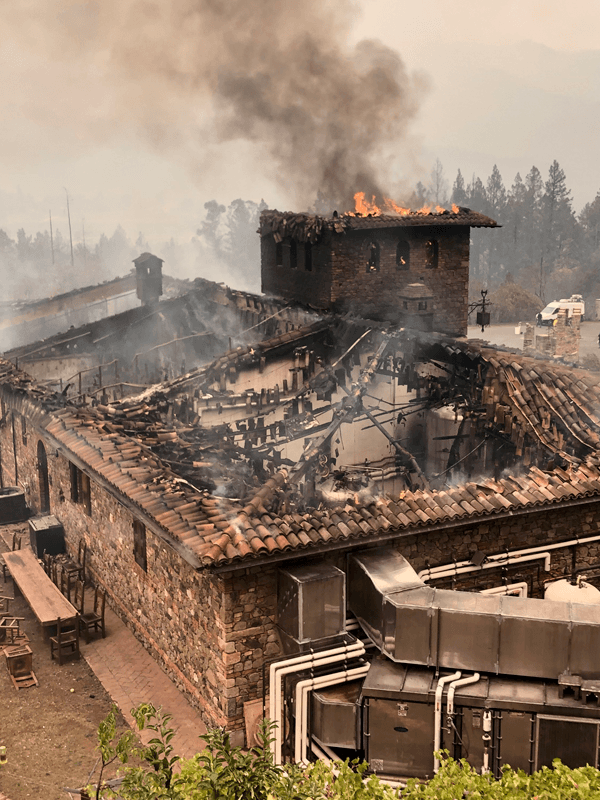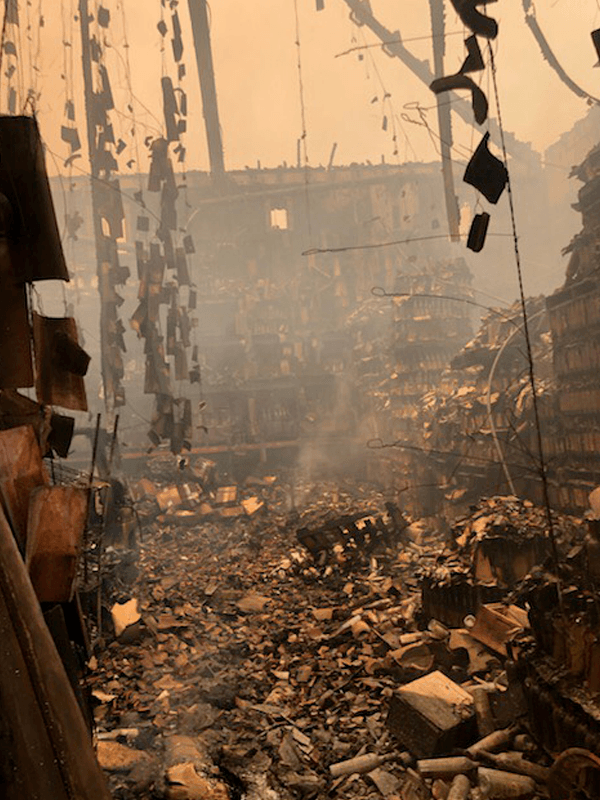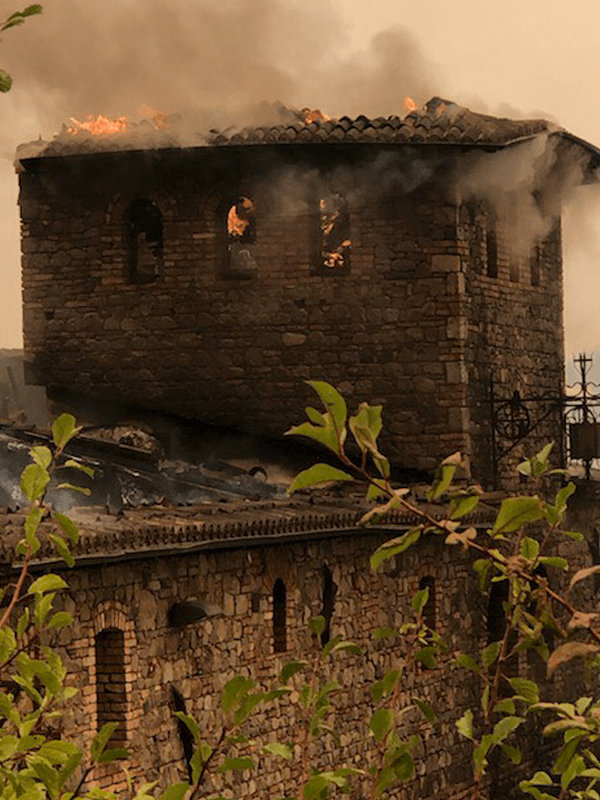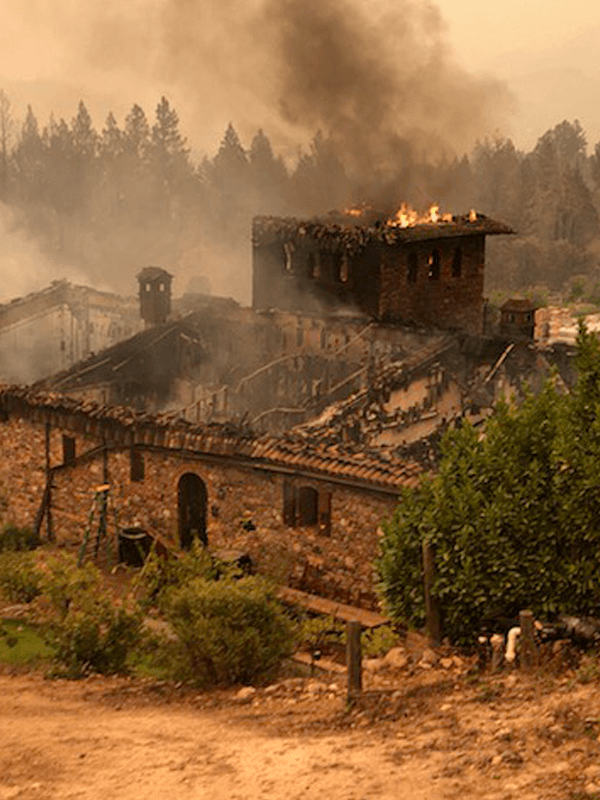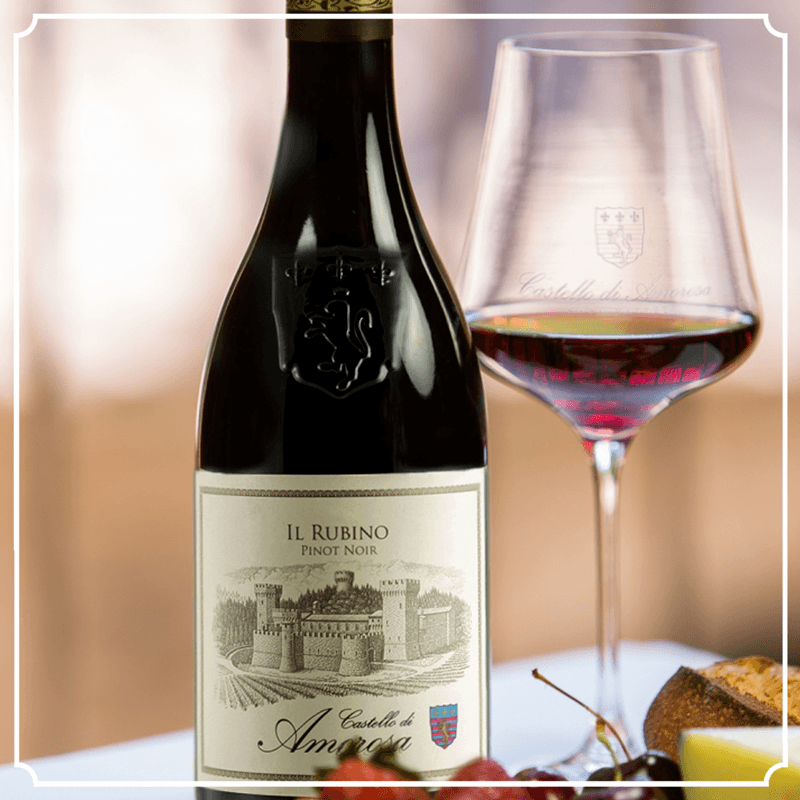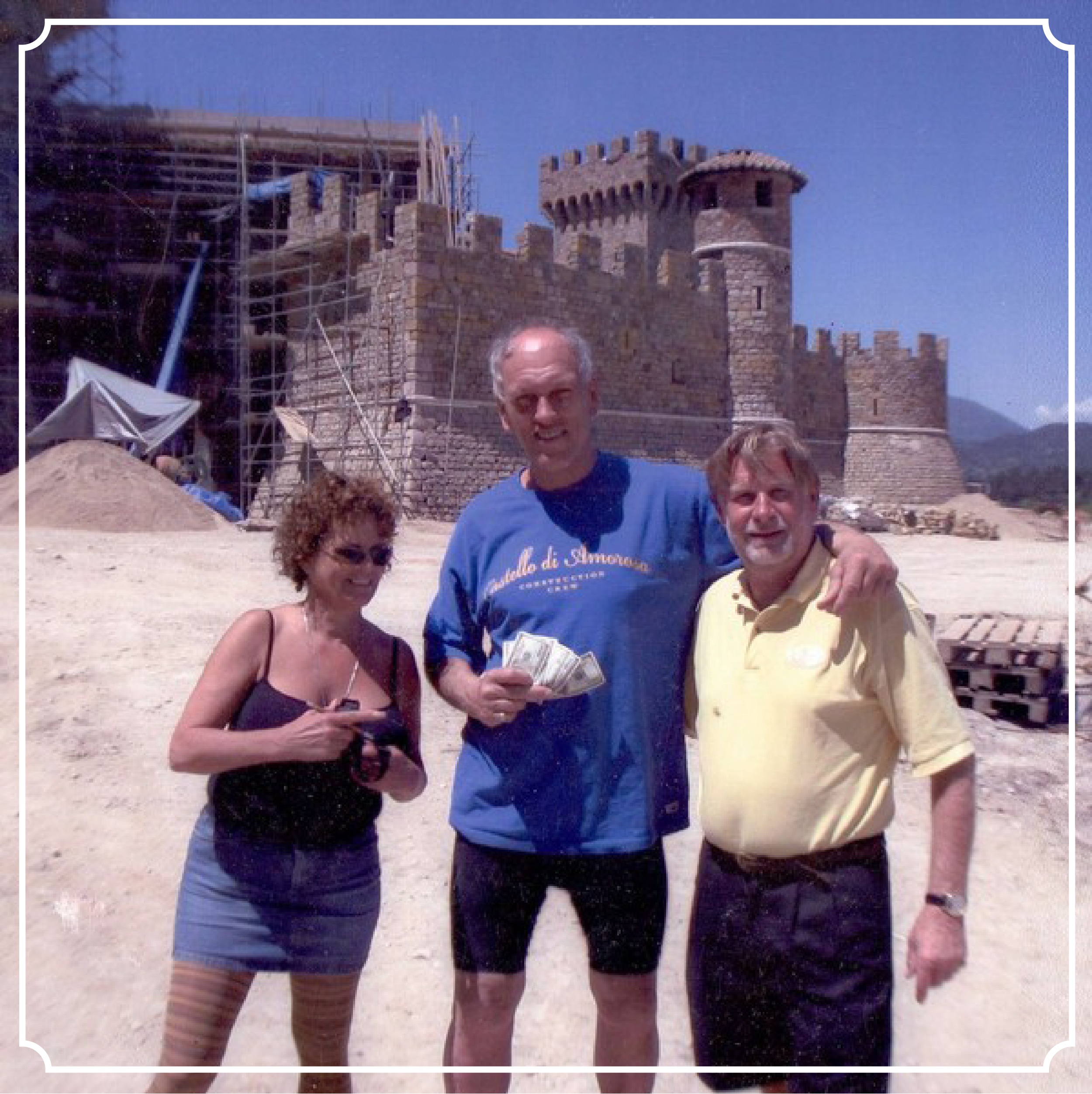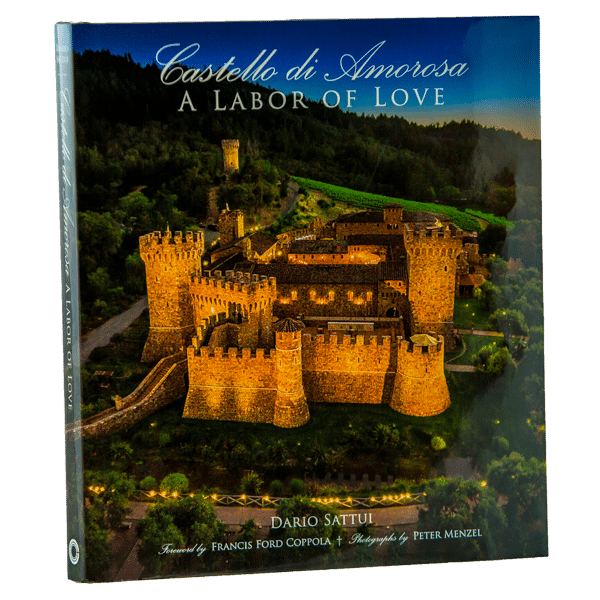Operation Vine Removal and Replanting

Operation Vine Removal and Replanting
Castello di Amorosa, nestled in the hills just south of Calistoga in the northern end of Napa Valley, has long been a symbol of tradition, craftsmanship, and excellence. The Castello, built by pioneer winemaker and winery owner, Dario Sattui, has been recognized as an architectural masterpiece that combines centuries-old medieval material with state-of-the-art winemaking equipment.
For over 25 years, lush rows of Cabernet Sauvignon, Merlot, Sangiovese, Malbec, Primitivo and Petit Verdot vines surrounding the Castello have produced some of the region’s most coveted wines.

But change is in the air around the Castello. Starting in late September 2024, the vineyard will undergo a remarkable transformation—its iconic vines, which have given so much over the years, are being removed.
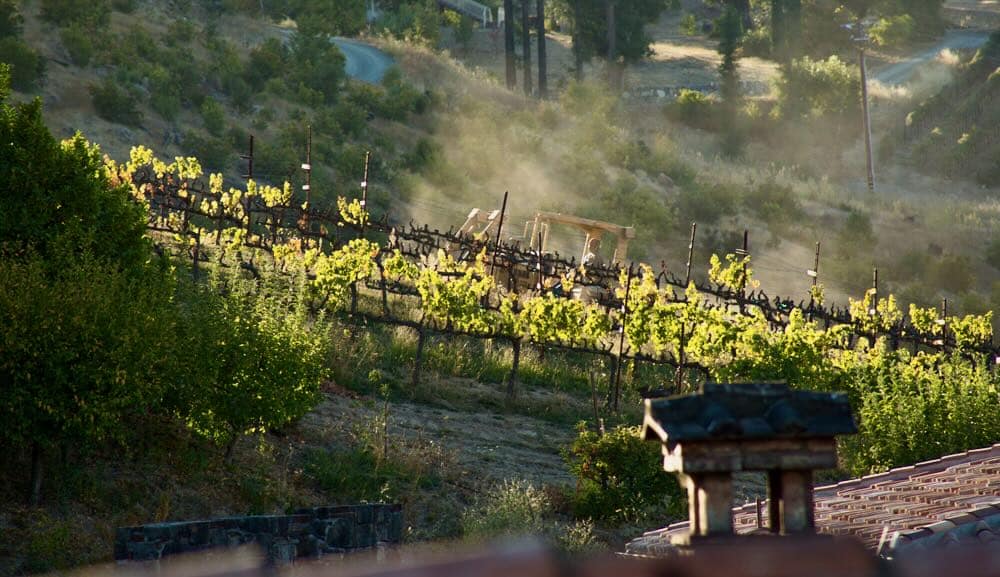
Time is of the essence. Erosion control ordinances require the vines to be removed and the erosion control to be implemented before October 15 and no work can be done until the following April when planting will begin. Vineyard blocks 5, 7 and 10 will be planted in April of 2025. The investment in vine removal and replanting is $1,000,000 for the ten acres of blocks being replanted.
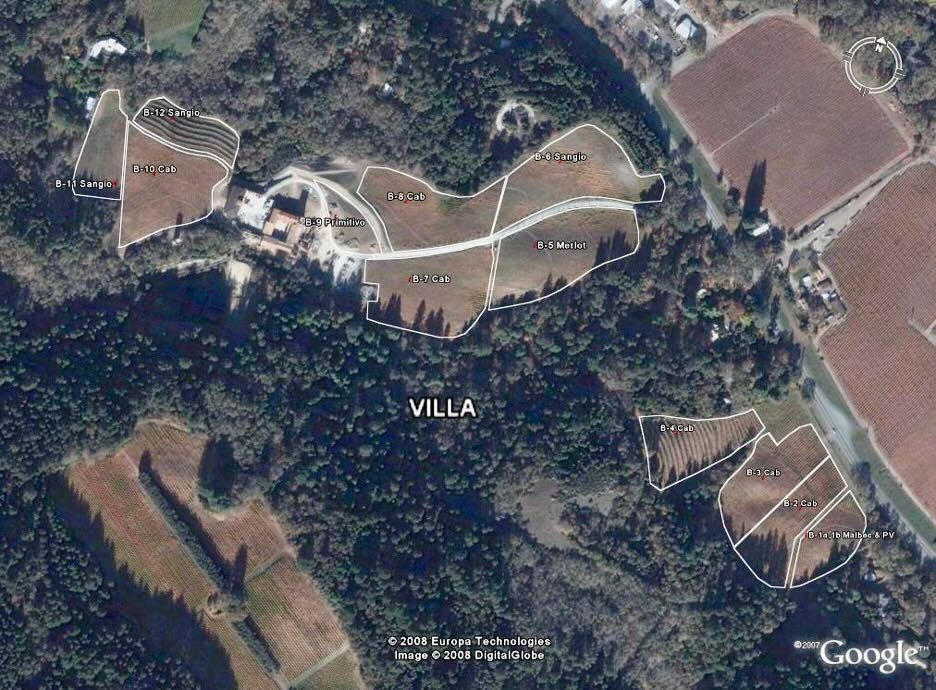
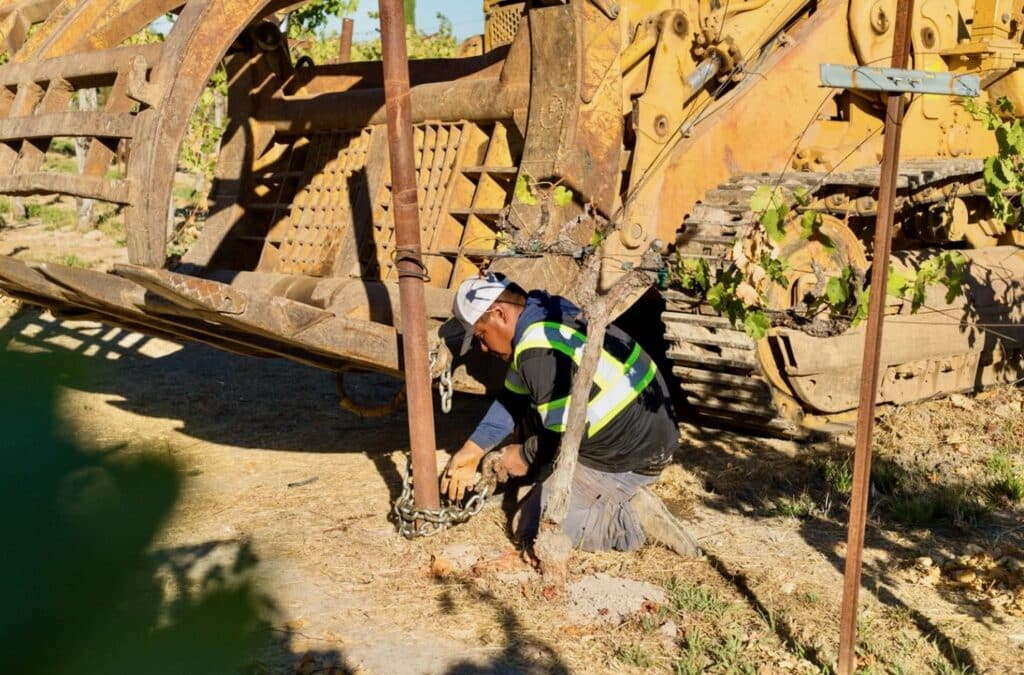

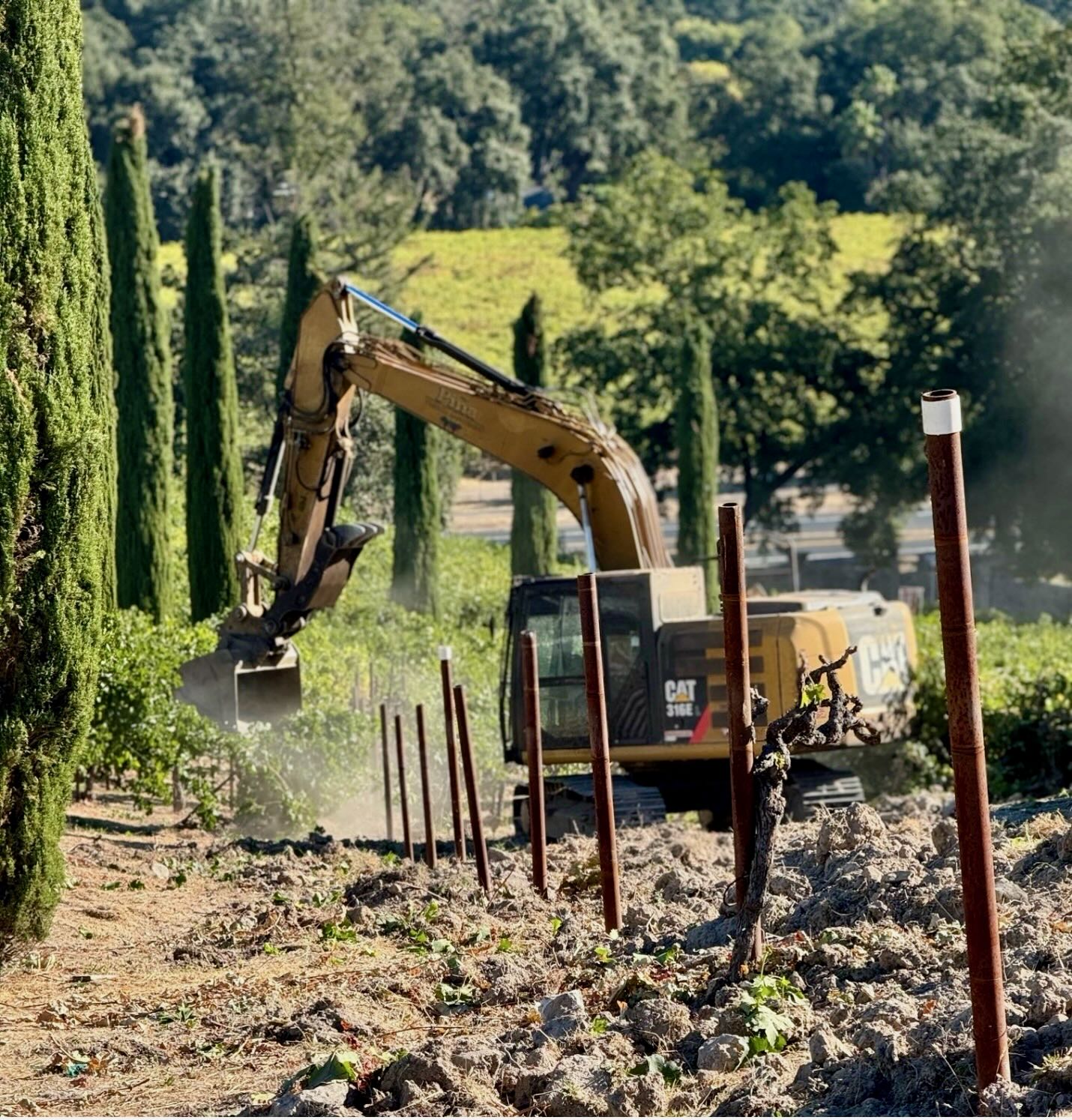
Over time, even the best vines begin to show their age. Though the wines from Castello di Amorosa have remained stellar, the vineyard’s team, led by visionary vintner, Dario Sattui, Castello President, Georg Salzner and Director of Winemaking, Brooks Painter, knew it was time to embrace renewal. “It’s a bittersweet moment as I can vividly recall the first planting of the Castello vineyards,” Sattui said, “but if we want to continue producing the highest quality wines for the next generation, we must replant. The terroir is the same, but the potential for what we can achieve is limitless.”
As we await the perfect moment to harvest, the work in our vineyards never ceases. One of the most important tasks at hand is ensuring our vineyards continue to thrive and produce exceptional fruit for future vintages. While many factors can influence the yield of grapes, the longevity of the vineyard depends heavily on the strategic replanting and care of the vines themselves.
As Dario Sattui explains, “Vines, like everything in nature, have a life cycle. While some vines can live for over 100 years, most of our vines reach their peak around 25 to 30 years. At this stage, their ability to produce optimal fruit diminishes, and that’s when we know it’s time to invest in the future of our vineyard.”
For Castello di Amorosa, this means carefully replanting select blocks of the vineyard, including blocks 5, 7 and 10, with Cabernet Sauvignon in 2025. The decision to replant isn’t made lightly, as it requires patience and foresight. By removing entire blocks, we have the unique opportunity to introduce new, disease-resistant rootstocks and clones of Cabernet Sauvignon that will elevate our winemaking legacy. “Replanting is a chance to secure our future,” Dario adds, “to ensure that Cabernet Sauvignon remains a cornerstone of our vineyards, delivering the quality and character our wines are known for.”
This process is about more than simply pulling out old vines; it’s about maintaining a balance between the vineyard’s current productivity and long-term prosperity. While pulling full blocks means those areas won’t yield grapes for a few years, the investment we’re making today is what will ensure Castello di Amorosa remains at the forefront of Napa Valley winemaking.
Gallery
Click on the images below to see them in high definition
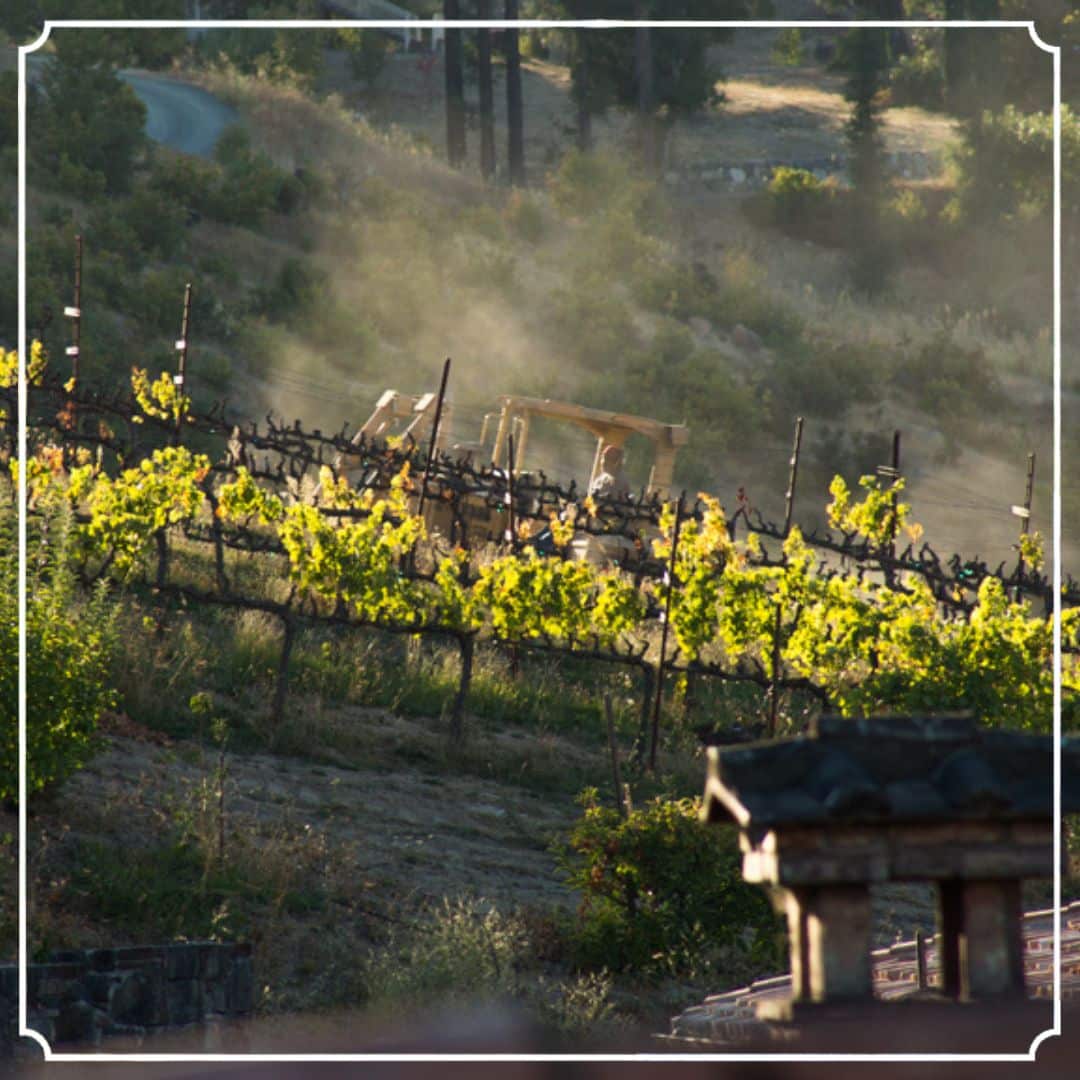
Jim Sullivan
Jim Sullivan, Vice President of Public Relations and Marketing spearheads Castello di Amorosa’s publicity and marketing initiatives.
With over 20 years of marketing, public relations and business development experience with professional motorsports teams and in a variety of healthcare organizations in Southern California, Jim first joined Castello di Amorosa in 2008 as Public Relations and Marketing Manager.
An avid cyclist, Jim fell in love with wine and wineries while exploring the Washington State countryside. His love of wine was reinforced during subsequent trips to the Napa Valley to visit family.
Jim holds an MBA from the University of Redlands and a Bachelor of Science from Central Washington University. He resides in Calistoga, Calif.
Overlooking the Napa Valley: The Melanson Vineyard

Overlooking the Napa Valley:
The Melanson Vineyard
Melanson Vineyard is one of a handful of exceptional vineyards that share an enchanted slope of land nestled among the rugged eastern ridges of the Napa Valley. It’s called Pritchard Hill. Most vineyards in the Napa Valley are based in one of the 16 American Viticultural Areas, or Sub-AVAs of the Napa Valley. Melanson Vineyard and 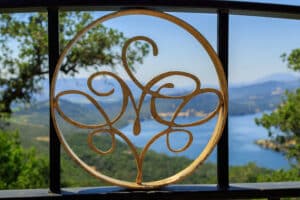 Pritchard Hill are not in a Sub-AVA but the Pritchard Hill growing region is arguably one of the top growing regions in all of Napa Valley. Sitting in peaceful isolation on a very steep, west-facing, boulder-strewn hillside, this 1,300 ft, 10.5-acre vineyard site enjoys late afternoon sun and remarkable views of Lake Hennessey below. Vineyard owner and wine grape grower Greg Melanson is serious about growing world-class Cabernet Sauvignon.
Pritchard Hill are not in a Sub-AVA but the Pritchard Hill growing region is arguably one of the top growing regions in all of Napa Valley. Sitting in peaceful isolation on a very steep, west-facing, boulder-strewn hillside, this 1,300 ft, 10.5-acre vineyard site enjoys late afternoon sun and remarkable views of Lake Hennessey below. Vineyard owner and wine grape grower Greg Melanson is serious about growing world-class Cabernet Sauvignon.
“As a master winemaker, Castello’s Brooks Painter understands you need great grapes to make a truly great wine,” said Greg Melanson. “The Cabernet Sauvignon flavors that are truly unique to Pritchard Hill are in every glass of Castello di Amorosa’s Melanson Vineyard Cabernet,” he added.
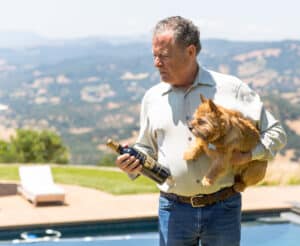
Several years ago, Castello di Amorosa began partnering with Greg Melanson and his meticulous vineyard manager, who carefully tends to the vineyard. The vineyard is planted in Sobrante loam soils, a clay loam mix, fractured volcanic material, and large volcanic rocks. Loam soils in general, and specifically Sobrante loam which allows the water to drain creating vine stress and mature flavor development in the grapes. The vineyard is known for its very small, intensely flavored grapes with thick skins. Melanson says the yields vary depending on what Mother Nature provides. Each vintage is different, and the yield is highly dependent on the weather.
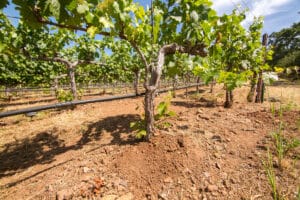 “I have a penchant for high-elevation vineyards,” said Brooks Painter, Director of Winemaking for Castello di Amorosa and V. Sattui Winery in St. Helena. “And upon first glance at this vineyard, I was immediately impressed with the intensity of the sunshine and the limiting growth potential of the vineyard soil.”
“I have a penchant for high-elevation vineyards,” said Brooks Painter, Director of Winemaking for Castello di Amorosa and V. Sattui Winery in St. Helena. “And upon first glance at this vineyard, I was immediately impressed with the intensity of the sunshine and the limiting growth potential of the vineyard soil.”
The Melanson Vineyard on Pritchard Hill sits well above the fog line which translates to plenty of sunshine to ripen the grapes. When tasting this Cabernet Sauvignon from this mountain terroir, you’ll immediately be struck by the soft, round mellowness of the wine. Its warm velvety nature with refined tannins on the palate continues to a long, complex finish that is full of fresh, dark fruit.
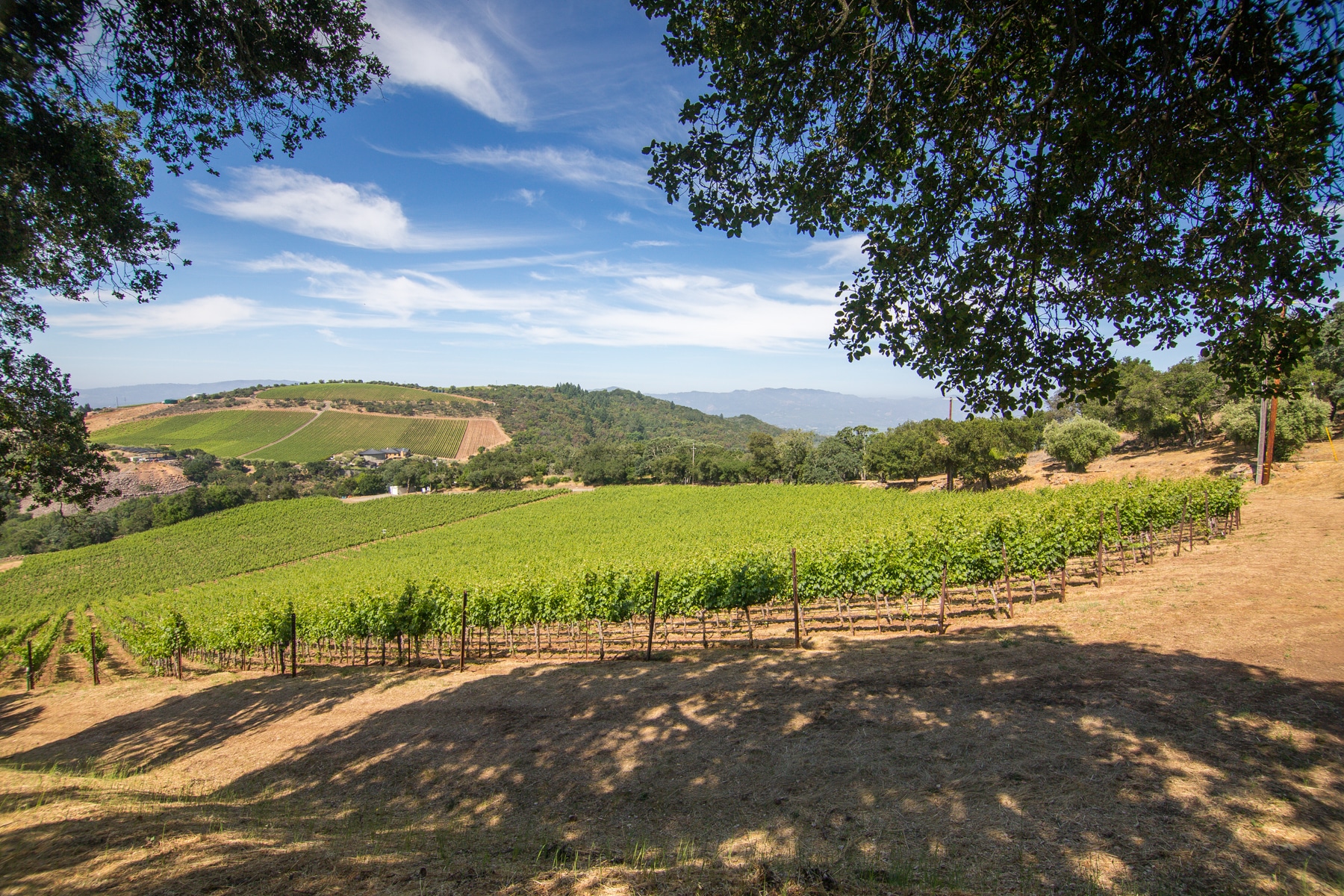
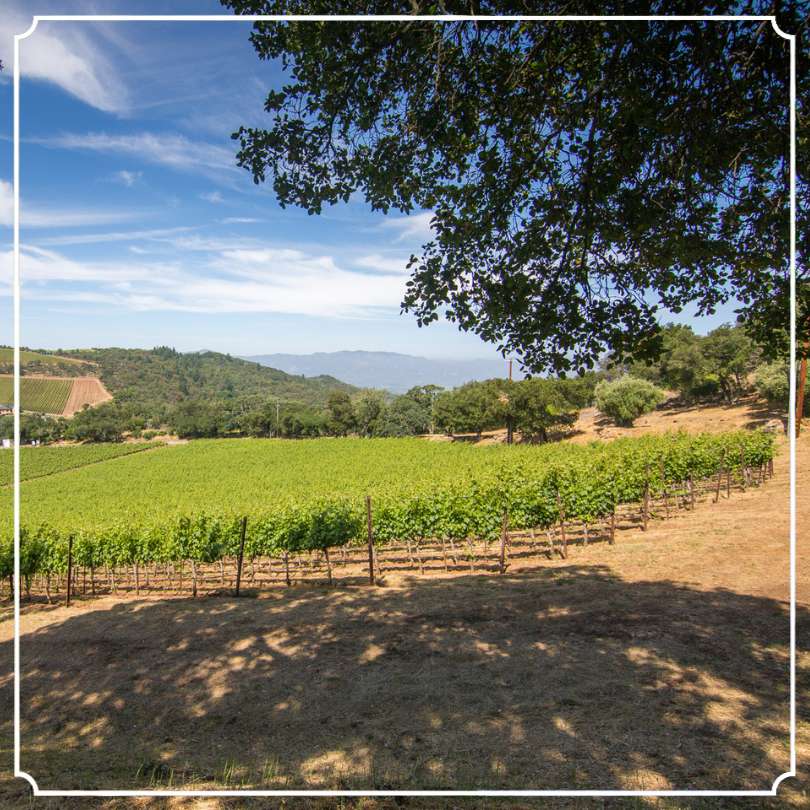
Jim Sullivan
Jim Sullivan, Vice President of Public Relations and Marketing spearheads Castello di Amorosa’s publicity and marketing initiatives.
With over 20 years of marketing, public relations and business development experience with professional motorsports teams and in a variety of healthcare organizations in Southern California, Jim first joined Castello di Amorosa in 2008 as Public Relations and Marketing Manager.
An avid cyclist, Jim fell in love with wine and wineries while exploring the Washington State countryside. His love of wine was reinforced during subsequent trips to the Napa Valley to visit family.
Jim holds an MBA from the University of Redlands and a Bachelor of Science from Central Washington University. He resides in Calistoga, Calif.
Introducing The Castello Fire Team

Jim Sullivan
Jim Sullivan, Vice President of Public Relations and Marketing spearheads Castello di Amorosa’s publicity and marketing initiatives.
With over 20 years of marketing, public relations and business development experience with professional motorsports teams and in a variety of healthcare organizations in Southern California, Jim first joined Castello di Amorosa in 2008 as Public Relations and Marketing Manager.
An avid cyclist, Jim fell in love with wine and wineries while exploring the Washington State countryside. His love of wine was reinforced during subsequent trips to the Napa Valley to visit family.
Jim holds an MBA from the University of Redlands and a Bachelor of Science from Central Washington University. He resides in Calistoga, Calif.
Introducing “Cavalieri del Fuoco,”
After experiencing the devasting effects of the Glass Fire in October 2020, the team at Dario Sattui’s Castello di Amorosa vows to be ready when the next Red Flag Warning is raised in the Napa Valley. Announced today was the formation of a newly assembled fire watch team, which will provide additional defense against fires during fire season and is equipped with fire protective gear and thousands of feet of fire hose, which attach to the Castello’s 3 fire hydrants on the property.
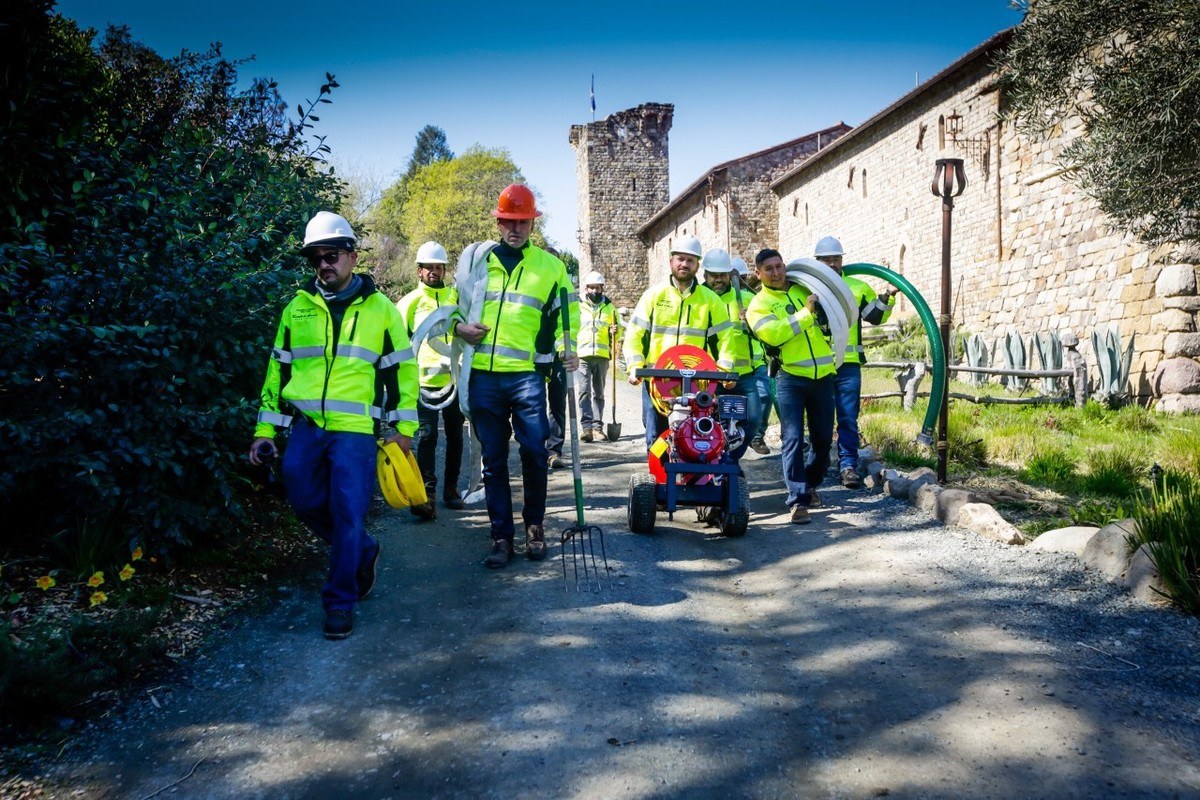
“The Glass Fire hit our Farmhouse so fast,” said Georg Salzner, President of Castello di Amorosa. “We were on site when it struck in the early morning hours, and we did what we could but felt like we could have done more to limit the damage. We could have been more of a resource to the firefighters who were stretched thin that night,” he added.
Salzner organized a fire defense team of 8 long-term employees who know the intricacies of the Castle, its grounds and Dario Sattui’s Victorian home just outside the main Castle gates. This team is known as the “Cavalieri del Fuoco,” which means the Knights of Fire in Italian. This team will establish a fire watch and be ready to respond during Red Flag Warning conditions and will provide support for firefighters. On an ongoing basis they will establish and maintain a defensible space around all structures by removing as much threat from those structures as possible.
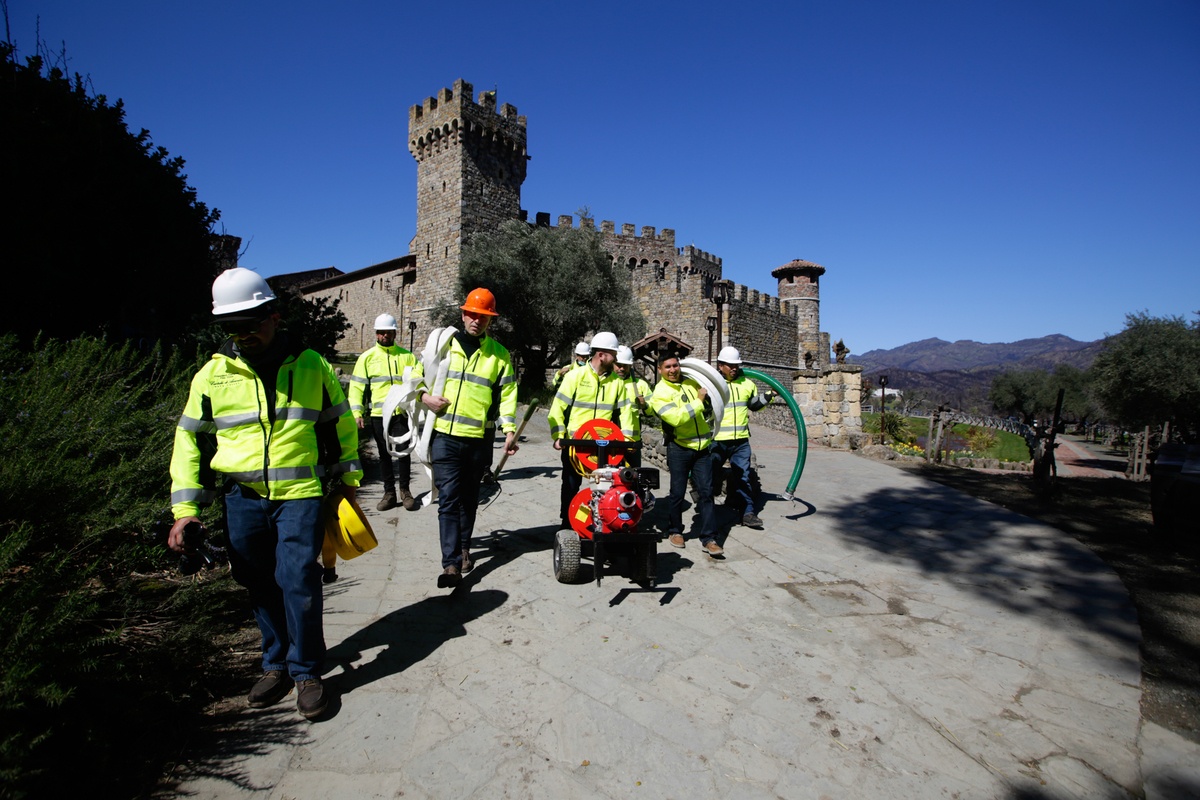
“It is critically important that we implement fire defensive measures now,” Salzner explained. “We’ve outfitted this team with the proper equipment. The entire perimeter of the Castello can be reached by the thousands of feet of fire hose that we purchased which will allow us to support the fire department’s efforts,” he continued.
The Cavalieri del Fuoco is led by Salzner, Tim Dexter, Maintenance Manager and Josh Fairbanks, owner of Fairbanks Mechanical (manages all mechanical systems at the Castello including the fire safety equipment). Long-time employee Carlos Perez is the official Fire Chief of the Cavalieri.
“Our main goal,” explains Tim Dexter, “is to have and maintain a defensible space of 150 feet from all structures to flammable vegetation. Smaller brush, tree trimming (branches lower to the ground) and tree clearing will be done using our newly acquired wood-chipper. This process will eliminate fire fuel sources which will prevent fires from becoming a threat. Regular gutter cleaning will take place in the summer and fall to eliminate fuel sources near roof lines. The new hoses will allow us to water down roof tops as well,” he adds.
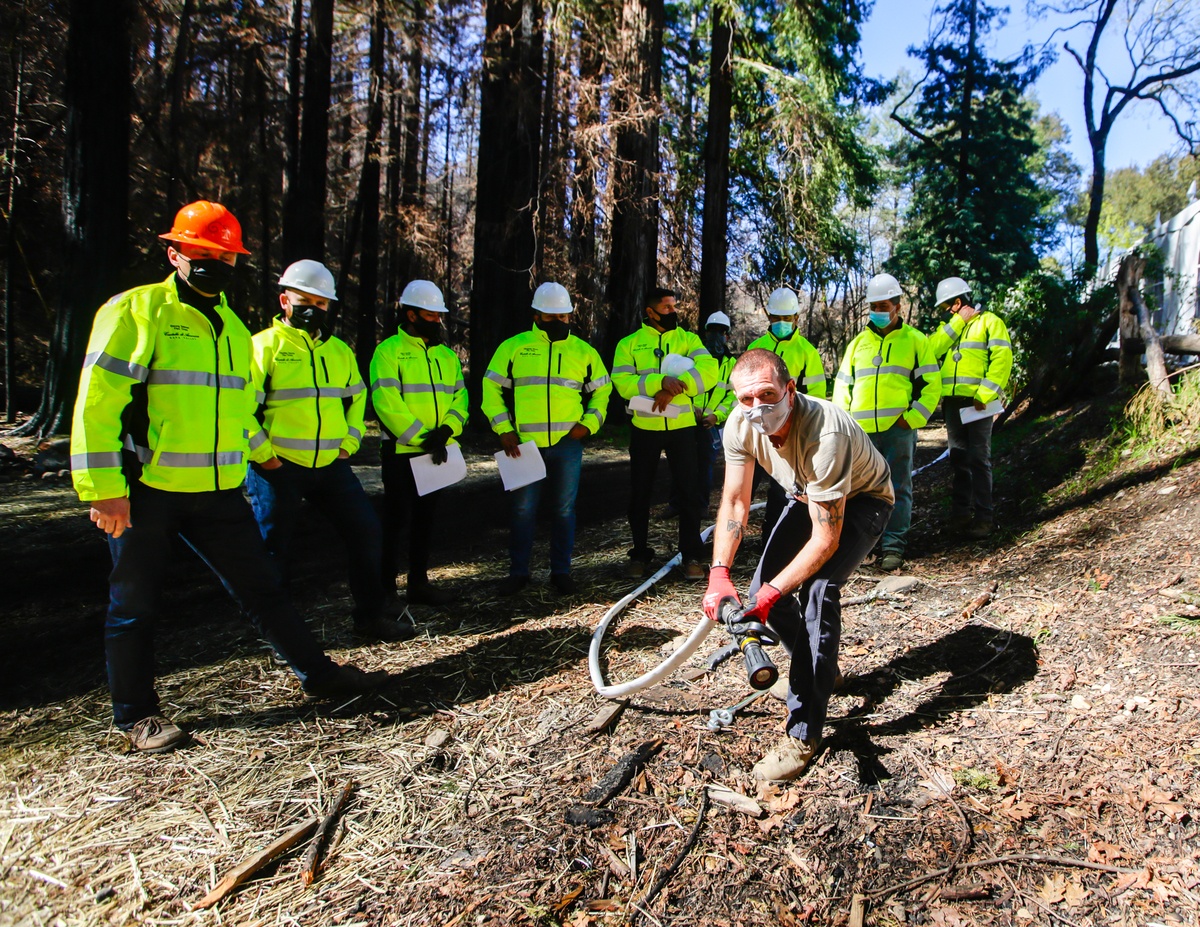
To make the property less susceptible to fire, the Castello invested nearly $100,000 in gear for the fire defense team and equipment which includes a portable water pump that obtains water from the lake, adaptors for the existing fire hydrants, thousands of feet of high-pressure fire hose and nozzles plus custom firefighting gear for the employees.
Each hydrant can be outfitted with dual 4” hose attachments, which allow the use of 1.5” fire hoses. The fire defense team then attaches the hoses to the fire hydrant and can begin to extinguish the fire with a strong water stream which can reach distances of 150 feet.
Castello di Amorosa is one of Napa Valley’s most recognized wineries and welcomes visitors by appointment seven days a week.
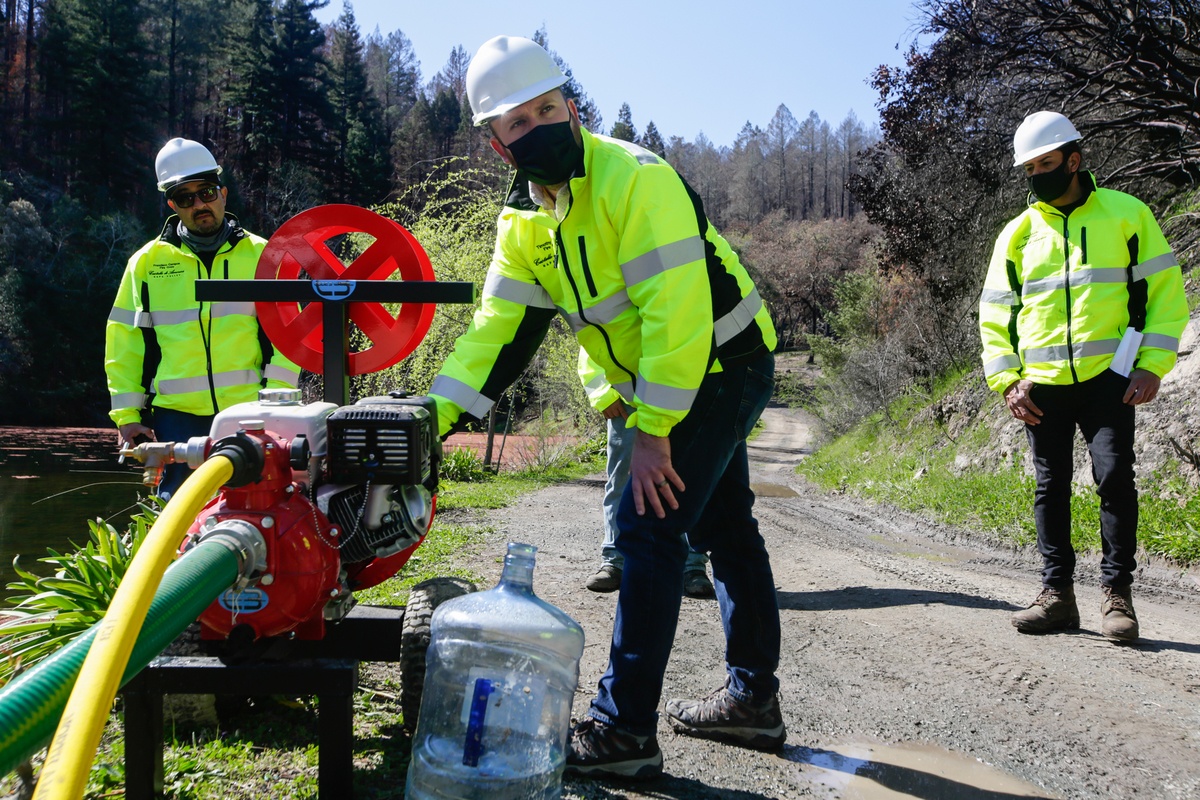
Glass Fire Part I
Read Part 1 of our Glass Fire Blog, featuring a message from Dario Sattui.
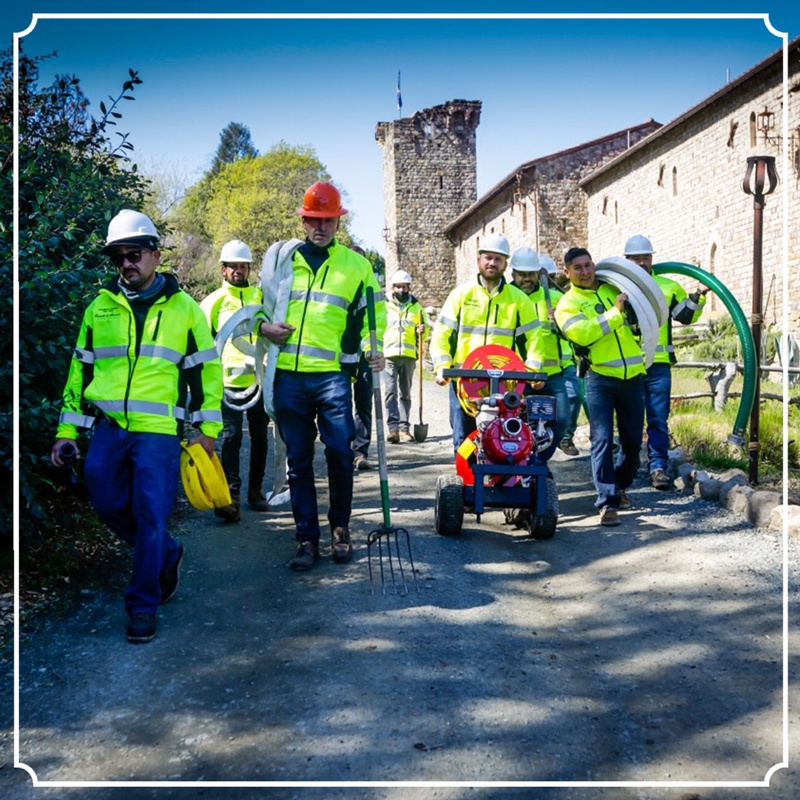
Glass Fire Part II

Jim Sullivan
Jim Sullivan, Vice President of Public Relations and Marketing spearheads Castello di Amorosa’s publicity and marketing initiatives.
With over 20 years of marketing, public relations and business development experience with professional motorsports teams and in a variety of healthcare organizations in Southern California, Jim first joined Castello di Amorosa in 2008 as Public Relations and Marketing Manager.
An avid cyclist, Jim fell in love with wine and wineries while exploring the Washington State countryside. His love of wine was reinforced during subsequent trips to the Napa Valley to visit family.
Jim holds an MBA from the University of Redlands and a Bachelor of Science from Central Washington University. He resides in Calistoga, Calif.
The Clean Up Is Complete
After 1,800 hours of work, the Farmhouse that was burned in the Napa Valley Glass Fire is clean and ready for rebuilding- a 2-to-3-year process- that will utilize same painstaking process that led to the building of Castello di Amorosa, also know as the Napa Castle
Dario hired Zucco Structural Engineers of Santa Rosa to evaluate the existing 10-inch cement walls that are faced with stone and bricks. Zucco were the engineers that produced the original structural plans for the Farmhouse. We are hopeful that the structural report confirms that the walls were not damaged to the extent that they will need to be razed.
Once we have confirmation, we will need to obtain a permit from Napa County to rebuild. We will need thousands of handmade, antique roof tiles, bricks, doors, and metal work from Italy as well as timbers. Artisans from Europe will need to come to Castello to perform the work, to recreate the Farmhouse exactly as it was before the Glass Fire.
In rebuilding the Farmhouse, Dario will reaffirm the two of the original guiding principles used in the building of the Castello. First, the building will be rebuilt authentically. Second, it will be authentic which means it will take time. The rebuilt Farmhouse will not be a contemporary building that mimicked the medieval style. As he would say, you cannot build an “old structure” using modern techniques and tools and it cannot be fake! So, like the Castle itself, you will see hand-shaped bricks, stone, roof tiles and wood used as the building materials.
Fritz Gruber, a master builder, who furnished most of the bricks from Austria will be called on once again in the Farmhouse rebuilding project.
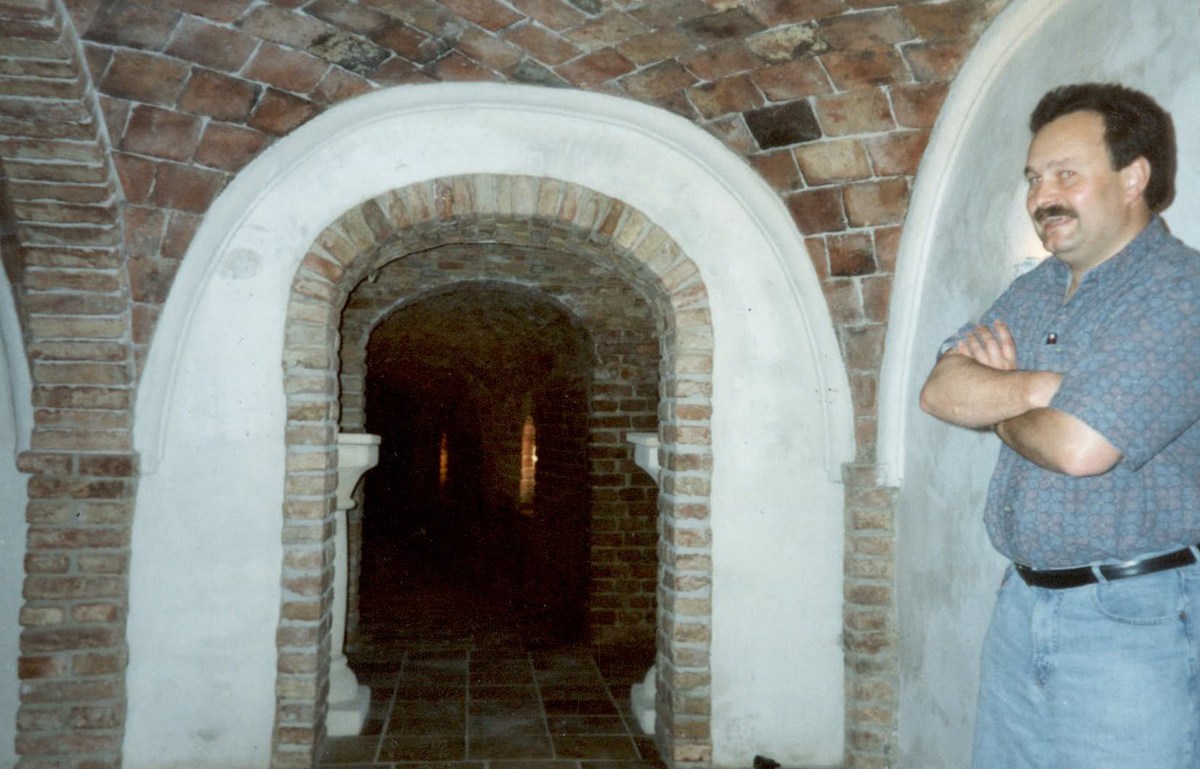
Much of the stone will be sourced locally and worked by masons familiar with old stonecutting techniques. The roof tiles are hand made by artisans in Europe.

The ironwork including the light fixtures, hinges, locks will all need to be fabricated by Giorgio Mariani, a blacksmith who Dario met in Assisi in 1998, and his son who reside in Umbria, Italy. These talented artisans created the wood doors and window surrounds for the Castle and we will ask for their help, once again, in the Farmhouse project.
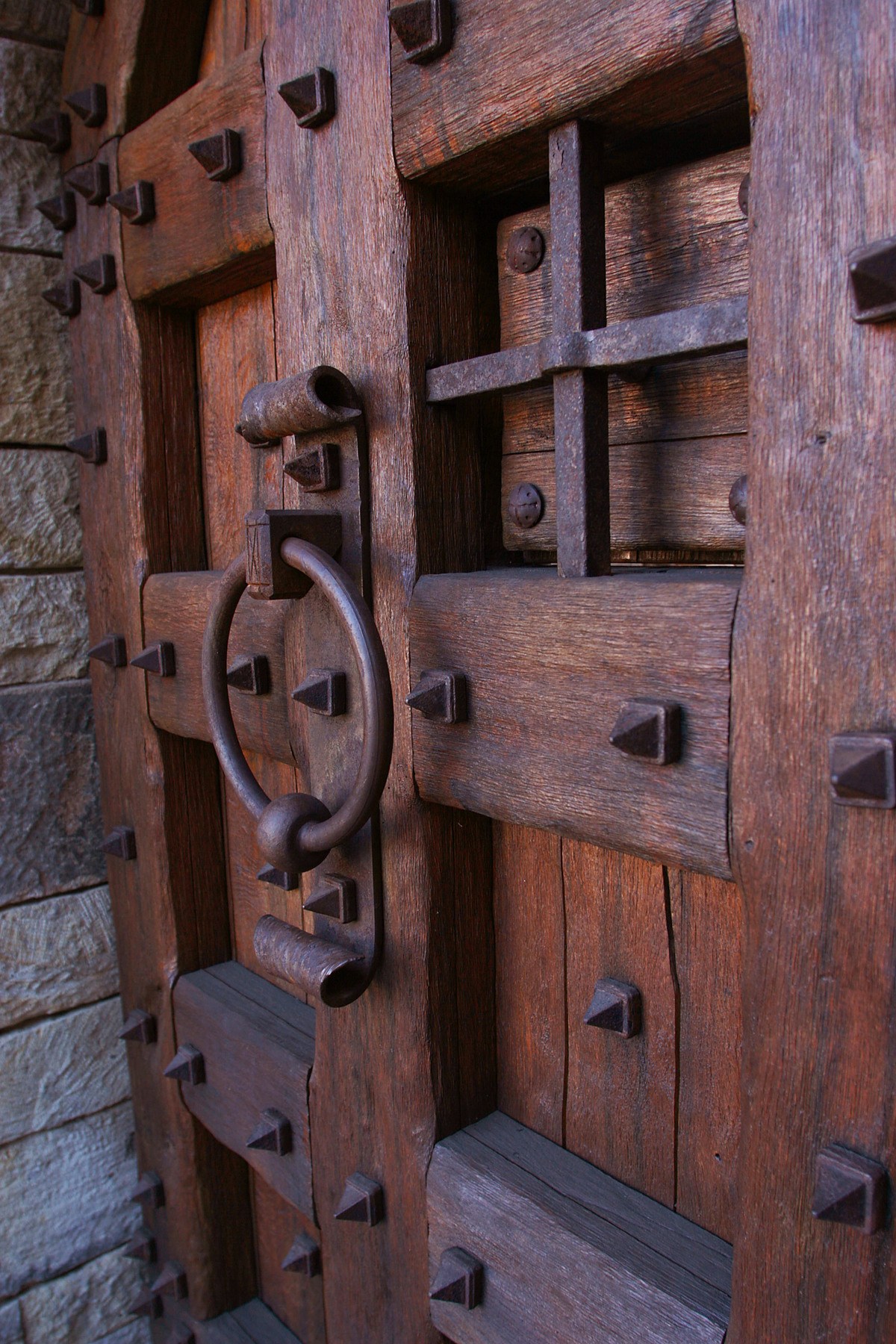
It is likely that the former construction manager of the Castle project, Paulo Ardito will return for the Farmhouse Project. It was Paolo who built the Gatehouse, a tractor barn and office/storage building that is left of the main gate in 2014.
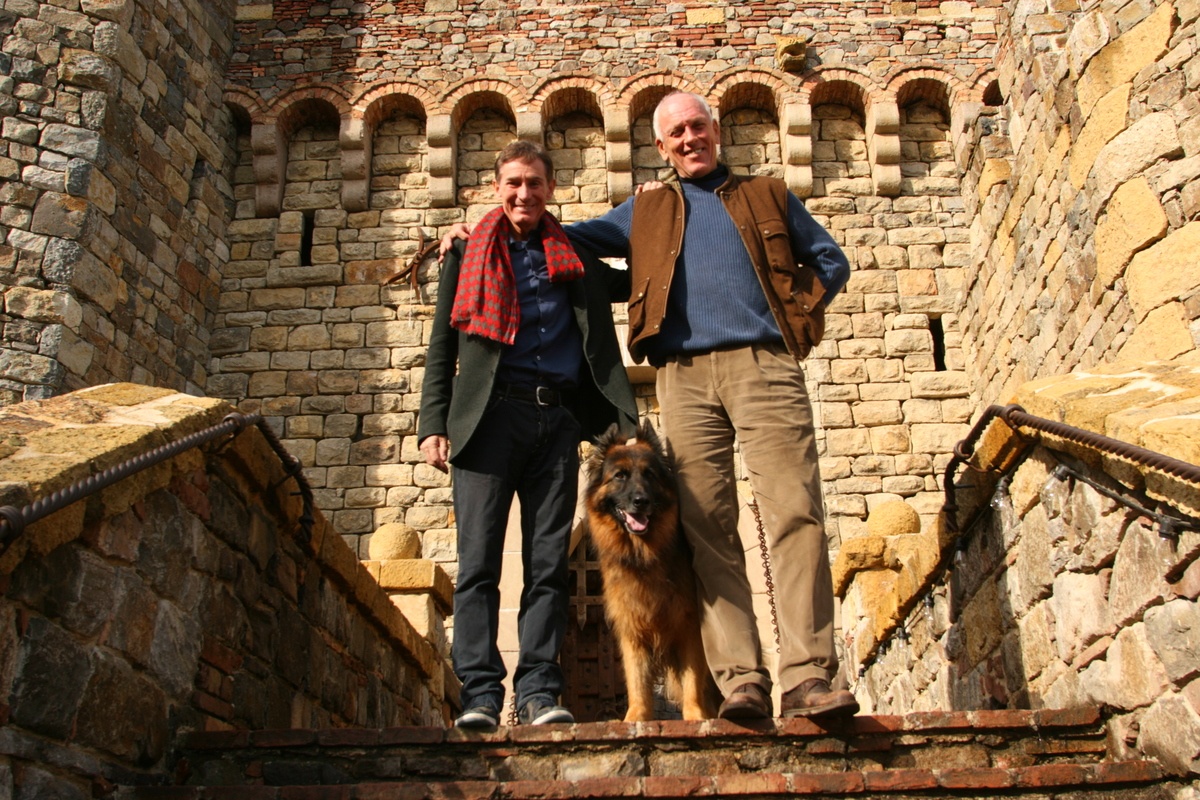
Stay tuned to this blog for the next update. If you have not already done so, please sign up for our newsletter (Hyperlink) to stay up to date with all the latest from the Castello.
Glass Fire Part I
Read Part 1 of our Glass Fire Blog, featuring a message from Dario Sattui.
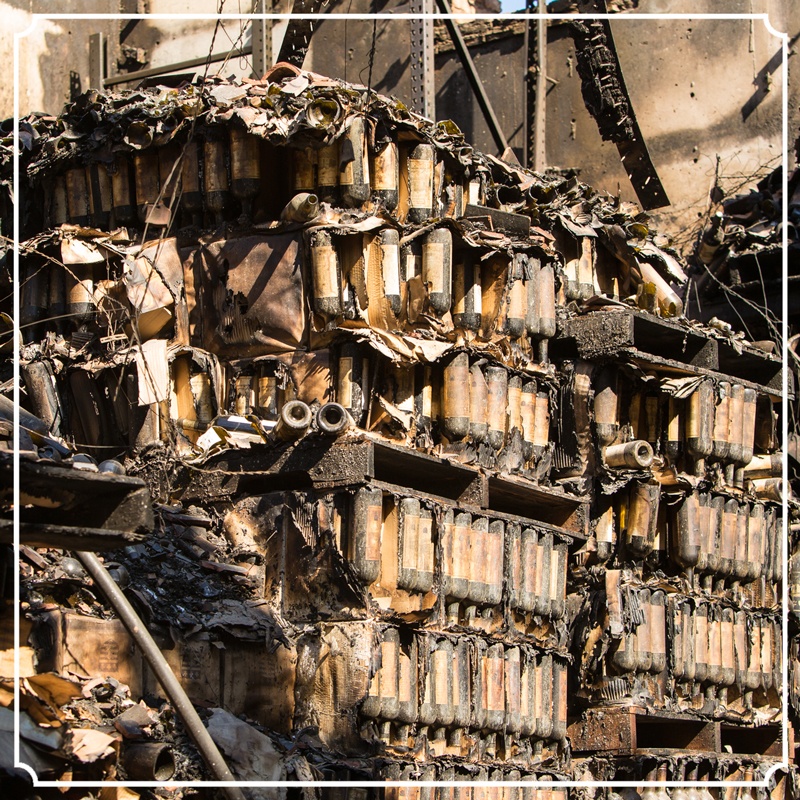
Glass Fire

Dario Sattui

Glass Fire Update
We have received an outpouring of love and support from our community and members, for which we are so grateful. In the midst of this challenging time, the team at Castello di Amorosa wishes to share with you a message of hope, fortitude, and resilience. While it is true that we have been affected by the fires, losing our Farmhouse building and scorched land surrounding the castle, we are grateful that our main castle building which spans 121,000 square feet has been left unscathed. We owe this to the hard work of the police, first responders, and firefighters that have continuously dedicated their efforts to saving our beautiful property. After seeing the flames, Dario’s first instinct was to save all of the animals at the castle, including the pigs, goats, sheep, emus, peacocks and chickens.
Looking to the future, it is time for us to come together as a community and to support one another. Wine country is strong, courageous and resourceful and we will get through this challenging time together and more unified than ever before. The incident has been heart-wrenching and devastating for the Castello di Amorosa Team, but through the tumult, our team and the spirit of Dario’s Labor of Love persisted.
– Castello di Amorosa Team
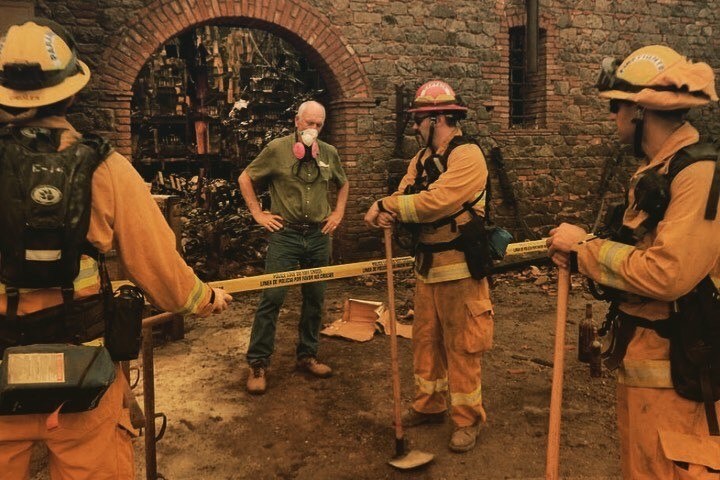
A Letter from Dario Sattui
Dear Friends & Family,
I spent nearly 15 years of my life designing and building the castle, which besides my wife Irina, is the second love of my life. I never thought the stone and brick fortress would be affected by fire. Unfortunately, in the early morning hours of September 28th, Castello di Amorosa sustained significant fire damage to the Farmhouse building, a separate 15,000 square foot building across the crush pad about 50 yards from the castle itself. The Farmhouse was completely destroyed. The beautiful castle itself and underground cellars which comprise approximately another 121,000 sq. ft. were not harmed by the fire.
Flaming embers landed in the grass near Highway 29 creating a massive fire that ripped up the hill to the Farmhouse before I knew it. My first response was to let our farm animals out of their pens, and then I raced to find a fire truck which responded quickly, but it was just too large a fire to handle. Fortunately, most of our wine inventory is stored in the castle and in our off-site warehouse and is in great condition.
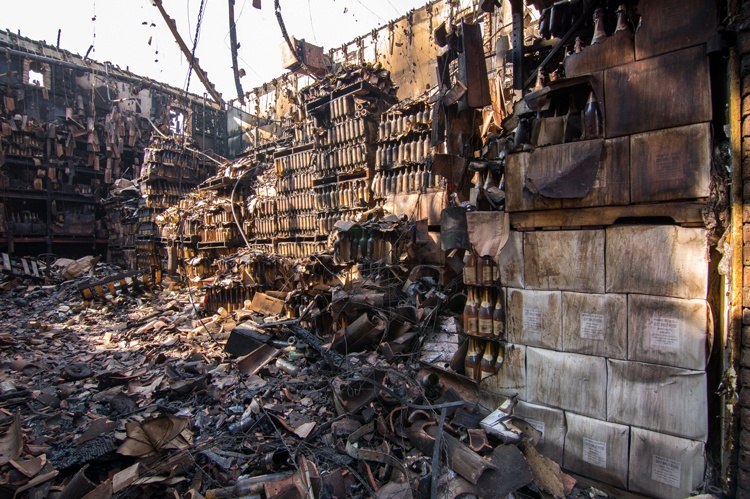
The Farmhouse contained about 120,000 bottles of wine with a retail value of approximately $5 million, a bottling line, a portion of the wine from the 2020 vintage and offices and a laboratory above. The castle itself was unaffected by the fire. I estimate that repairing this craftsman building and re-equipping it will cost approximately $10-12 million and take 2-3 years as most of the antique materials must come from Europe. The estimated total loss is approximately $15-20 million.
I really appreciate your heart-felt support during this difficult time. Your calls, emails and wine orders are very much appreciated. I am thankful for your support of the castle and honored that you continue to purchase and enjoy our wine which will help sustain the castle during this horrible time.
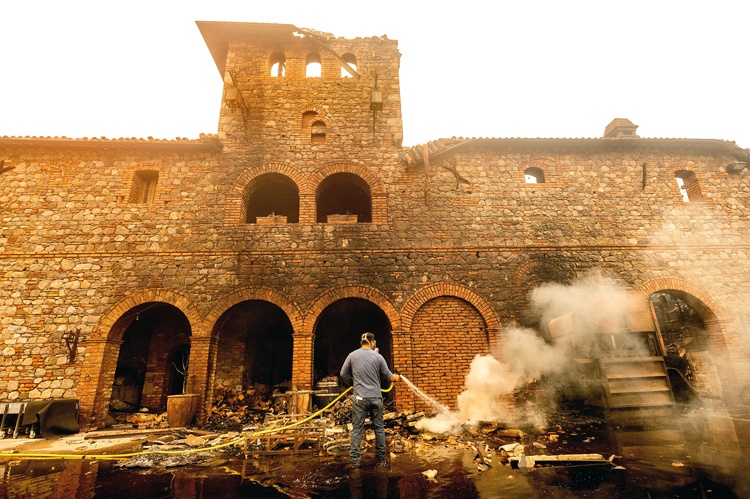
I am thankful that no one was injured and want you to know that we are strong and resilient, and we will overcome this tragedy. Our hearts go out to our friends and neighbors, some of whom have suffered great losses. We are forever grateful for the hard work and dedication of the brave fire fighters and the first responders.
We are already hard at work repairing systems and getting back on our feet.We expect to resume shipping your wine orders by the end of the week and to reopen the castle within a week for wine tasting.
I am looking forward to putting this disaster behind us and hosting you again at the castle soon.
I wish you and your family all the best.


Farmhouse Update
No one ever thought the 2020 Glass fire of September 28 which started on the east side of the Napa Valley near Crystal Springs road would ever make it to the east side of the valley. But the unthinkable quickly became reality at the hands of the fierce, 40 mph winds that fateful evening.
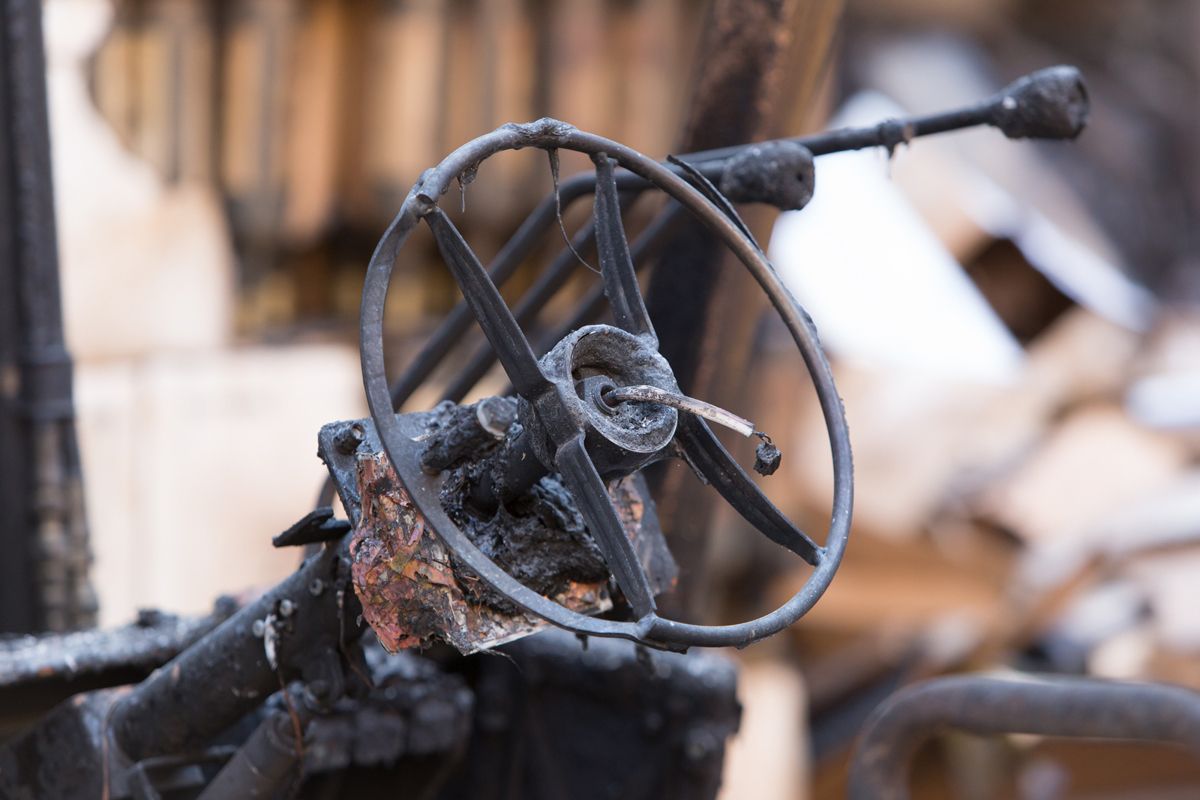
Dario Sattui was worried. He was up at 1:00 a.m. to assess the conditions. He drove to the Napa River and found the fire just 50 yards east of the Napa River, which was only 350 yards from the Castle. He noticed that the fire had consumed the entire field, but it appeared to extinguish itself as there was no more fuel to feed the flames. The fire department put out most, but not all, the remaining spot fires. Dario believed the spot fires coming to a 12-foot-wide gravel road would die out but was concerned about the high winds that evening.
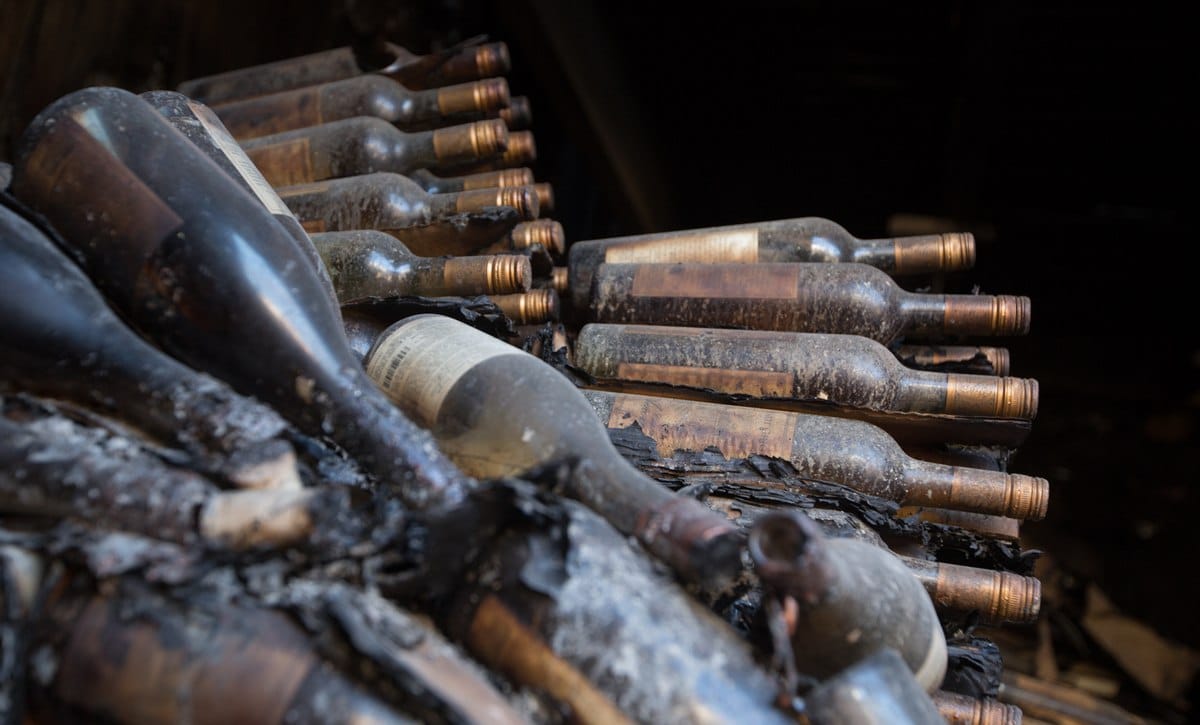
He reasoned there was no way the fire could reach the Napa River, let alone cross it. Certainly, it was impossible the fire could cross the main highway 45 feet wide, so he went to sleep at 2 a.m. At 3:45 a.m., a neighbor woke him to say the fire was on the Castle’s side on the highway. He did not entirely believe her, but quickly dressed and drove up the highway. Sure enough, the fire was on the Castle side of the road and in an instant, it roared up the gully into the backside of the Castle’s beloved Farmhouse causing major damage

Some of Castello di Amorosa’s most precious wine was stored in the Farmhouse. In total, over 110,000 bottles of wine were destroyed including some of the Crown Jewel Collection of Il Barone, La Castellana and single vineyard Cabernet Sauvignon’s from Don Thomas Vineyard in Rutherford, Morisoli-Borges Vineyard in Rutherford, Melanson Vineyard on Pritchard Hill and Castello’s Super Tuscan Blend, Sinalunga named for a small commune near Siena, Italy which inspired Dario to build the Castello.
Perfect Pairings Dynamic Duo

Mary Davidek
Perfect Pairings Dynamic Duo
The first time I saw the man who would eventually become my husband I was dumb-struck (quite a confession those who know me will attest). Just my type; tall, dark (it was summer), and handsome. After a chat over a glass of vino (what else?), I made the fatal mistake of telling him I thought he was smarter than I was. I say fatal mistake as it is now 24 years later and he won’t let me forget that statement.
24 years later and he won’t let me forget that statement.
Our friends often tell us they have never met 2 people more suited for each other, meant to be together. Better together as 1 than separate as 2. Like peanut butter and jelly, milk and cookies, peas and carrots……it just works.
Perfect pairings certainly enhance and intensify and one thing which is singularly good, but with food and wine, perfect pairings take on a new meaning. If you have ever been on the Royal Pairing Tour at Castello di Amorosa you may have experienced a few of these perfect pairings. A rich pate’ with Castello’s award winning Il Passito comes to mind. Sommeliers agree this match is perfection. Popular wine writer Karen Macneil says “this luxurious pairing comes perilously close to maxing out the human tolerance for pleasure”. An endorsement like that certainly piques the imagination. But, must perfect pairings always be so lofty, and quite candidly, so costly to be perfect? Does perfection have a price? A rule of thumb, pair rich with rich and humble with humble. One of my affordable favorites, a simple roast chicken (any grocery store’s rotisserie is fine), and a bottle of Pinot Noir. The rustic flavors of a simple roast chicken, a loaf of crusty bread and the earthy tones of Pinot Noir are magical together. When selecting your pinot go for light and fruity bottlings from Sonoma. For my dollar Castello’s Los Carneros Pinot Noir is the perfect choice with a hit of clove balanced with bright fruit. This Valentine’s Day, a day dedicated to perfect pairings, celebrate this dynamic duo with your honey. Light a couple of candles, put in your favorite music, pour a couple glasses of vino and relax.
Throughout the year, connect with your inner match-maker; go forth and discover new and exciting pairings.
And remember, perfection is in the eyes of the beholder……
Cheers and Happy Valentine’s Day
Mary Davidek C.S., C.S.W
A History of the Project - Part III

Dario Sattui
Castello di Amorosa: A History of the Project: Part III
After more than 15 years of research, I was ready to build my castle in the Napa Valley.

And I had my first paying customers, Peter Thomas. They love the Napa Valley. Photo taken April 29, 2006.
I had accumulated a wealth of knowledge on medieval architecture, a huge library of books, photos, plans and detailed sketches. I couldn’t wait to get started. The renovation of my historic Victorian at the bottom of the hill on the same property would have to wait. I was going to build my castle first.
Within a short time of acquiring property on which I would build, Lars Nimskov, the naval architect from Denmark, came from Italy and we began working on plans which were submitted and approved by Napa County a year later.
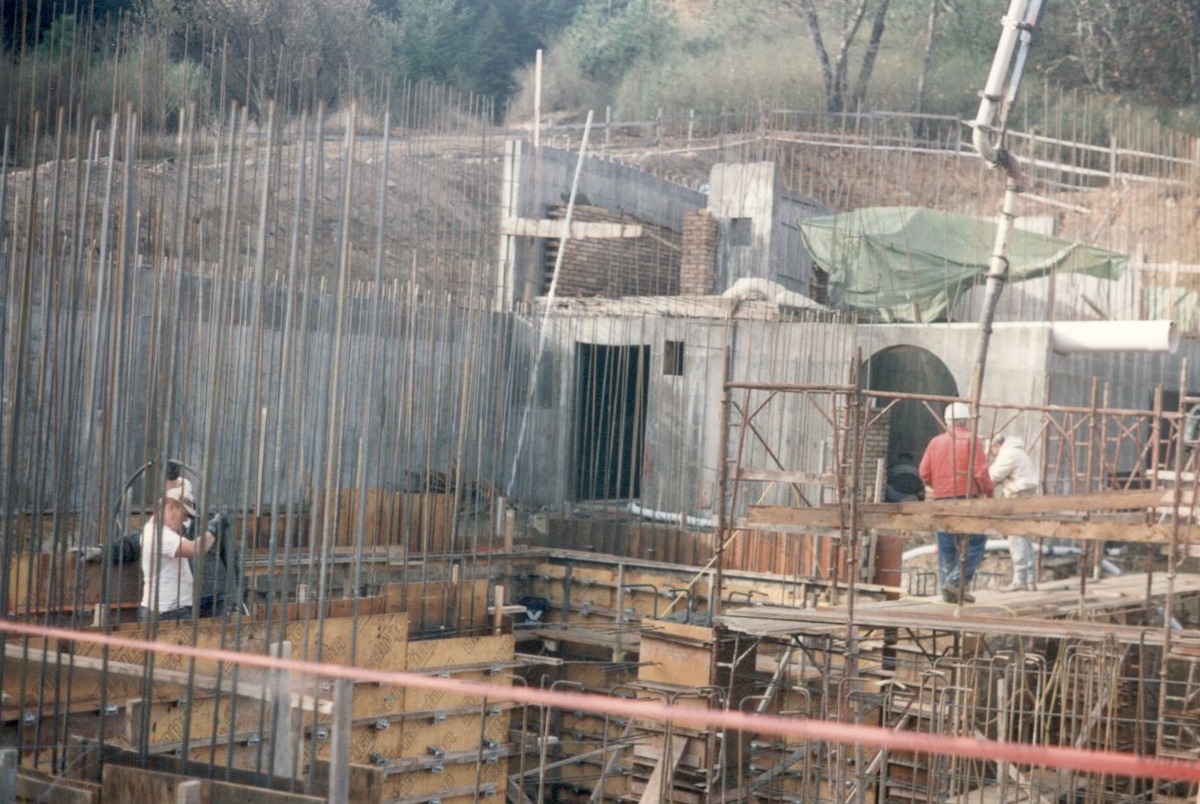
Lars Nimskov (in red jacket) oversees construction of Castello di Amorosa in 1998.
We would build the underground cave and cellars first. Then we would build the castle walls, towers, and all above ground structures. I had been saving my money for years. I was sure that with my savings coupled with current earnings I could manage financially if I were prudent in other areas. Construction I figured would take about five or six years. Boy, I was wrong on both accounts!
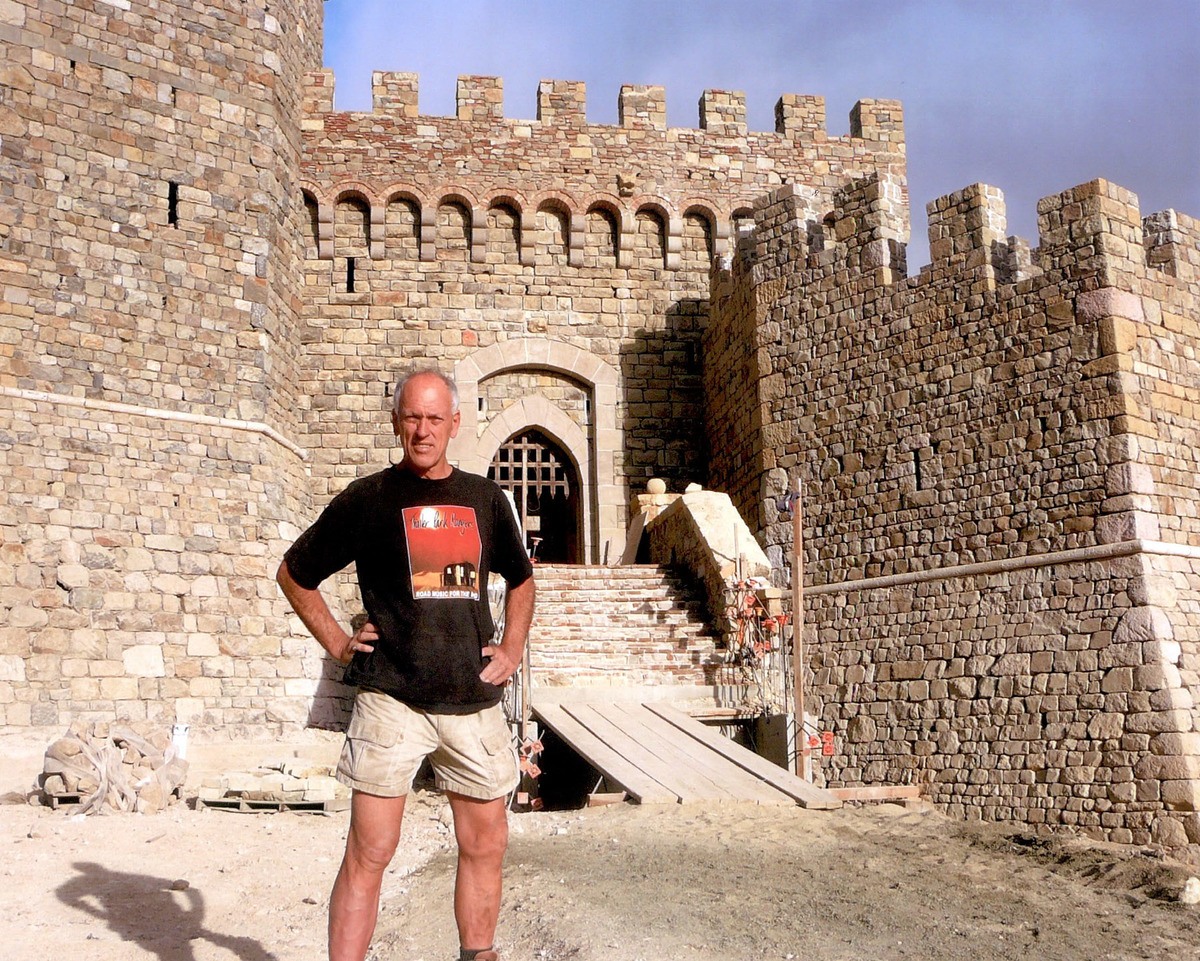
Dario Sattui, September 18, 2006. The Drawbridge is under construction. (Photo: Pat Daniels)
On January 5th, 1995, we began construction of 900 linear feet of caves. We hired a firm that used a Welsh mining bore which excavated horizontally into the hillside at a rate of 15 feet per day. In five and a half months, the caves were finished; the perfect environment for aging wine with cool, constant temperatures and high humidity. The problem was we now had a mountain of excavated, poor-quality soil we didn’t know what to do with.
And the excavating was just starting. We had three more underground levels (originally one level until I expanded the building) of cellars to excavate and then build. The mountain of dirt became progressively higher.
Fritz Gruber, the master builder from Austria and one of the few persons in the world who knew medieval building techniques, agreed to come for three months with six men. They were to build the first two rooms and show us how it was done. Shortly thereafter, seven men arrived and moved into my house along with Lars. None of them, save Fritz, spoke any English. My home had been turned into a boarding house. But I knew I had to skimp monetarily to see this project to completion.

Master builder, Fritz Gruber pictured with one of his works of art in Europe.
Three months later, Fritz and his men left for Austria. I was really concerned we would not be able to do complex medieval ceiling vaulting ourselves and we would have to stop building or construct ceiling which were not authentic. But Lars was very capable and, by observing for three months, figured out how to do it.
Through rain, occasional snow, cold, heat, and heavy winds, we built Castello di Amorosa, working six days a week, usually ten or more hours a day. Over the years, we employed builders from eight different countries and materials from five.
I kept changing and enlarging the plan, carried away with this obsession to build ever better and ever more. When things weren’t done absolutely authentically and correctly, we tore them down and started again. Along the way we kept referring back to source materials and photos, making sure that every minute detail was done properly.
As the years of building continued on, I divorced, lost my hair, became more wrinkled, was struck by a car crossing a San Francisco street, and endured a major flood and a slowdown of my energy. But I always kept building. The 5-6 year project expanded from the original 8,500 to 121,000 square feet and 107 rooms, all different. I went through my money- all of it. Then I sold all my stock to raise cash, often when the market indicated to do the contrary. When that money didn’t suffice, I sold my castle in Tuscany. I fired my housekeeper, then the gardener in an effort to save money to use in construction. I skimped everywhere I could to keep building. And the years of construction kept slowly rolling by. Instead of semi-retiring to Italy in 1994 as I had envisioned doing, I was working harder than ever at both V. Sattui, my original winery, and on building Castello di Amorosa. But I loved it. I couldn’t wait to get out of bed in the morning and hurry to the construction site.
Finally in 2005, I realized that I might not finish the project in my lifetime. I replaced Lars Nimskov, with whom I did not get along, but endured his bad temper because he understood what I wanted and was capable of doing it. I thought of hiring an American contractor, but those whom I had met lacked the knowledge of medieval construction and were intimidated by the project with no idea how to build it.
But through a friend, I found an Italian builder, Paolo Ardito from Bologna. We met at a freeway off ramp in Italy. We were wary of each other at first, but we both took a chance. He spoke virtually no English which complicated things, and out of necessity I communicated in my bad Italian. But somehow it worked. He brought over seven master masons whom I quickly sent back to Italy upon discovering that master builders they were not. I quadrupled the construction crew to 64 and we kept building.
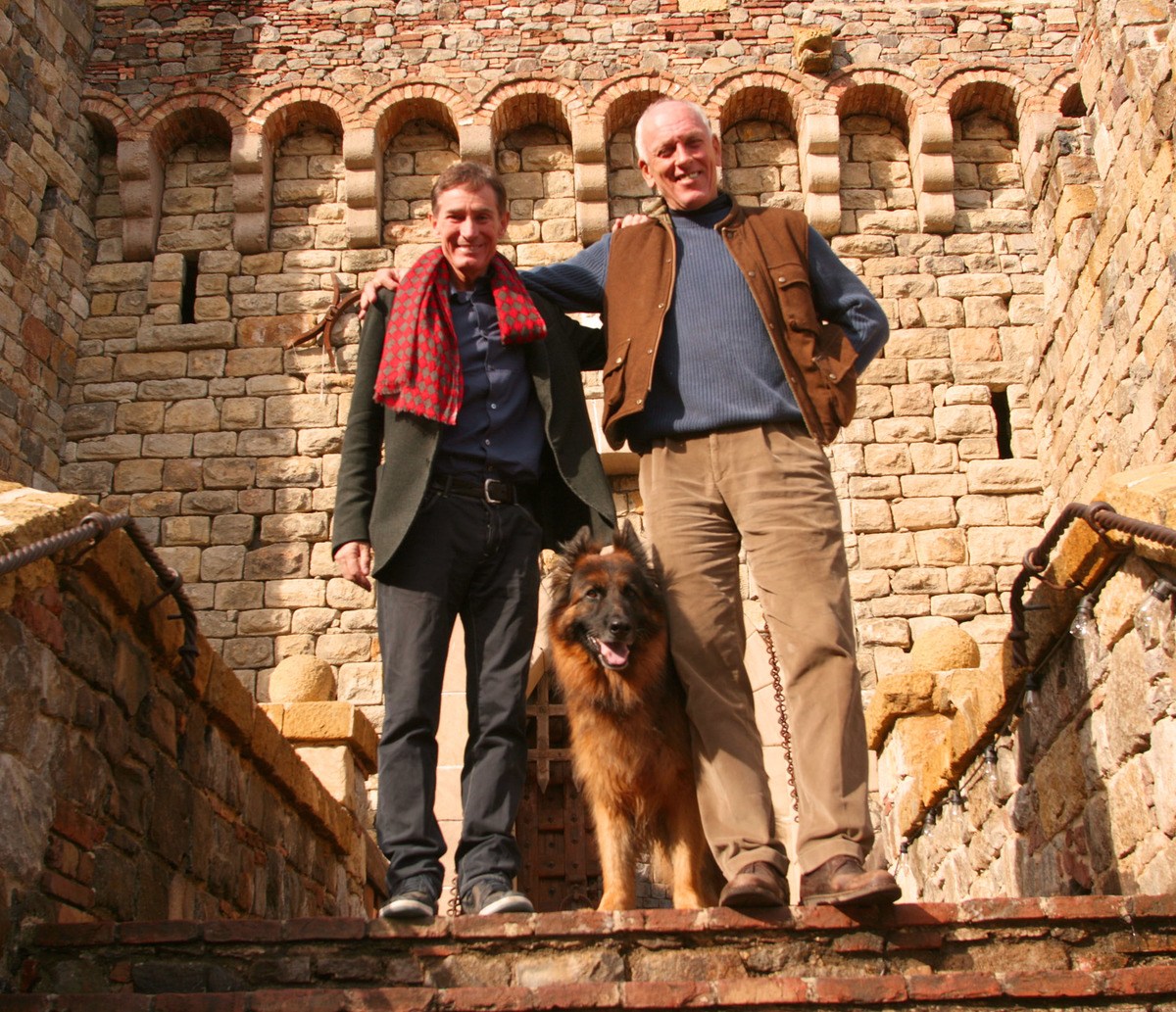
Dario Sattui and Paolo Ardito reconnect on the Drawbridge (with Dario’s dog, Lupo) in 2010. (Photo: Jim Sullivan 2010)
We worked over 10 years building underground, often seeing daylight only at lunchtime. We completed more than 80 rooms underground, each different, using all the ideas I had discovered after researching for many years in Europe. The square footage of the underground rooms alone, built on four separate levels, was nearly 80,000, or two acres. These rooms were to be barrel aging cellars and our wine tasting rooms.
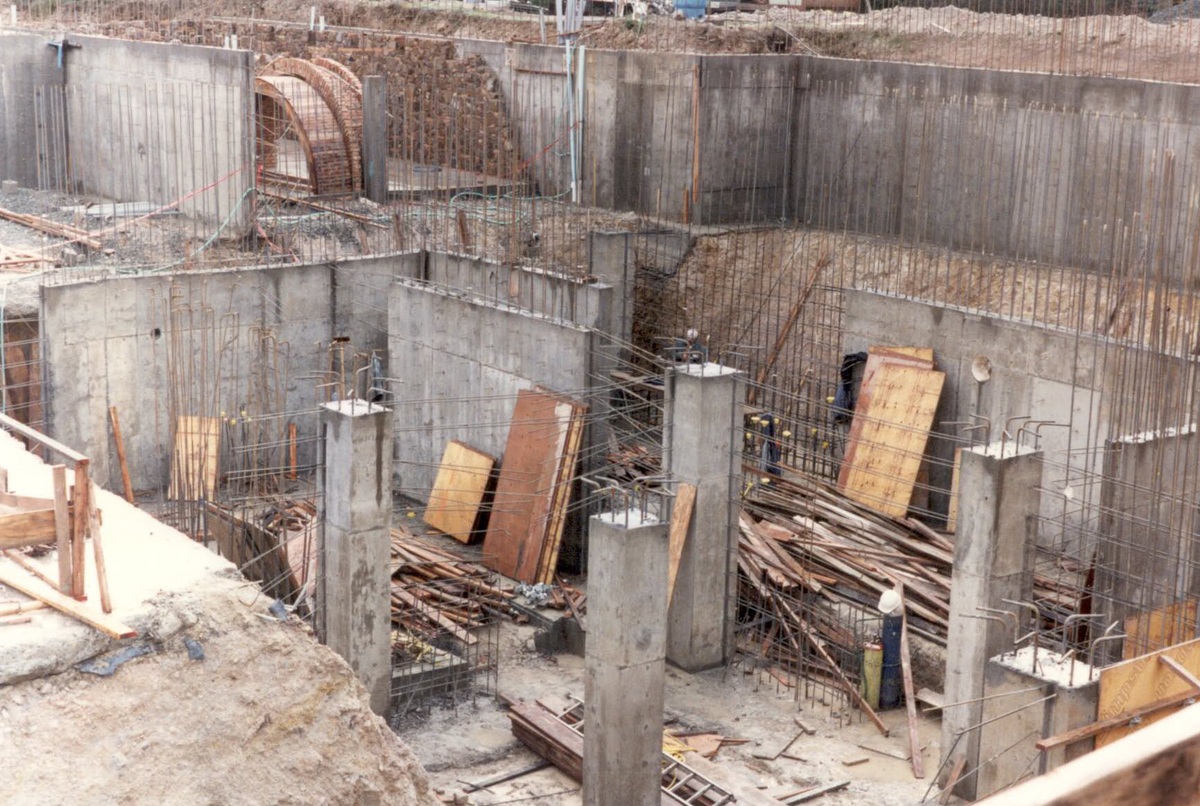
Construction of the cellars under the Tasting Room in 1998.
In 2004, we finally finished the underground portion and began building above.
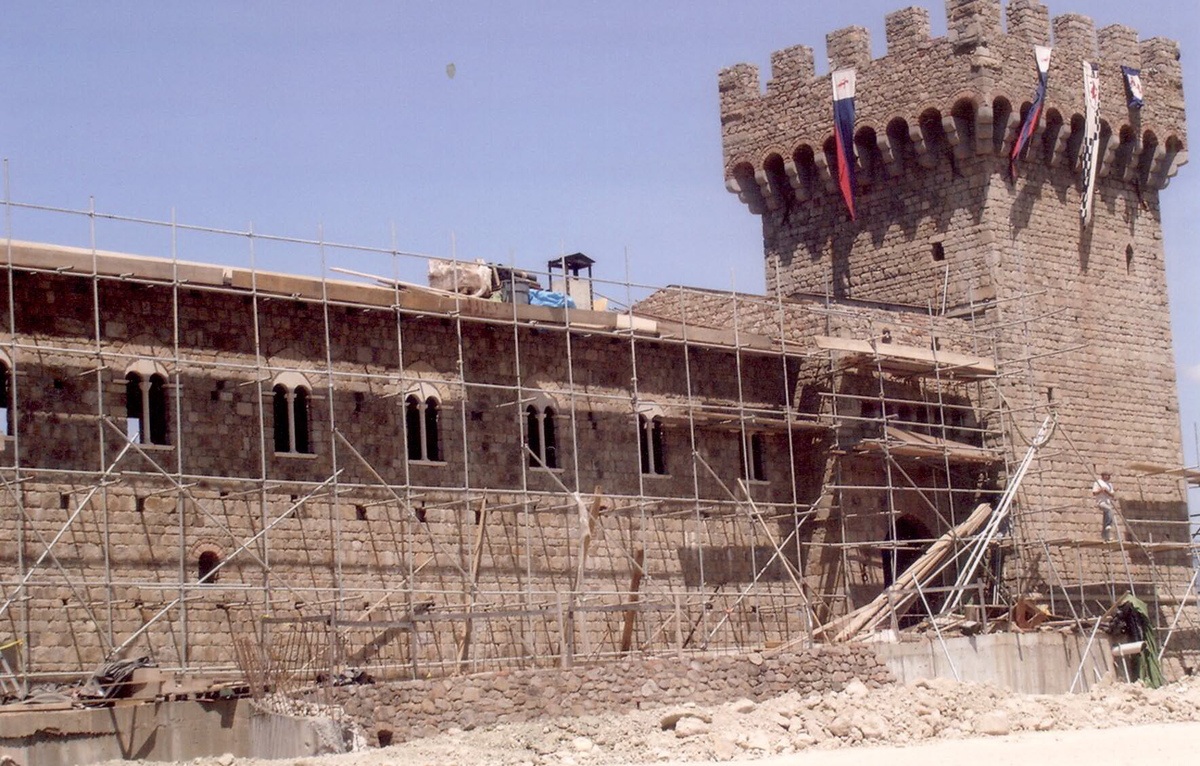
The Great Hall, entrance to Courtyard and North Tower under construction in 2005.
We constructed a dry moat, high defensive fortified walls, five towers, courtyards and loggias, a Tuscan farmhouse and other outbuildings. We erected archways, a big kitchen, a Great Hall that took one and a half years to completely fresco. We built stables, an apartment for the nobles, wine fermenting rooms, a church and chapel, secret passageways, and even a prison and torture chamber. I was bent on being totally authentic incorporating every element of a real 12th – 13th century Tuscan castle. I attempted to depict how castles evolved over time, by erecting doorways and niches and then bricking them up. We built a partially destroyed tower.
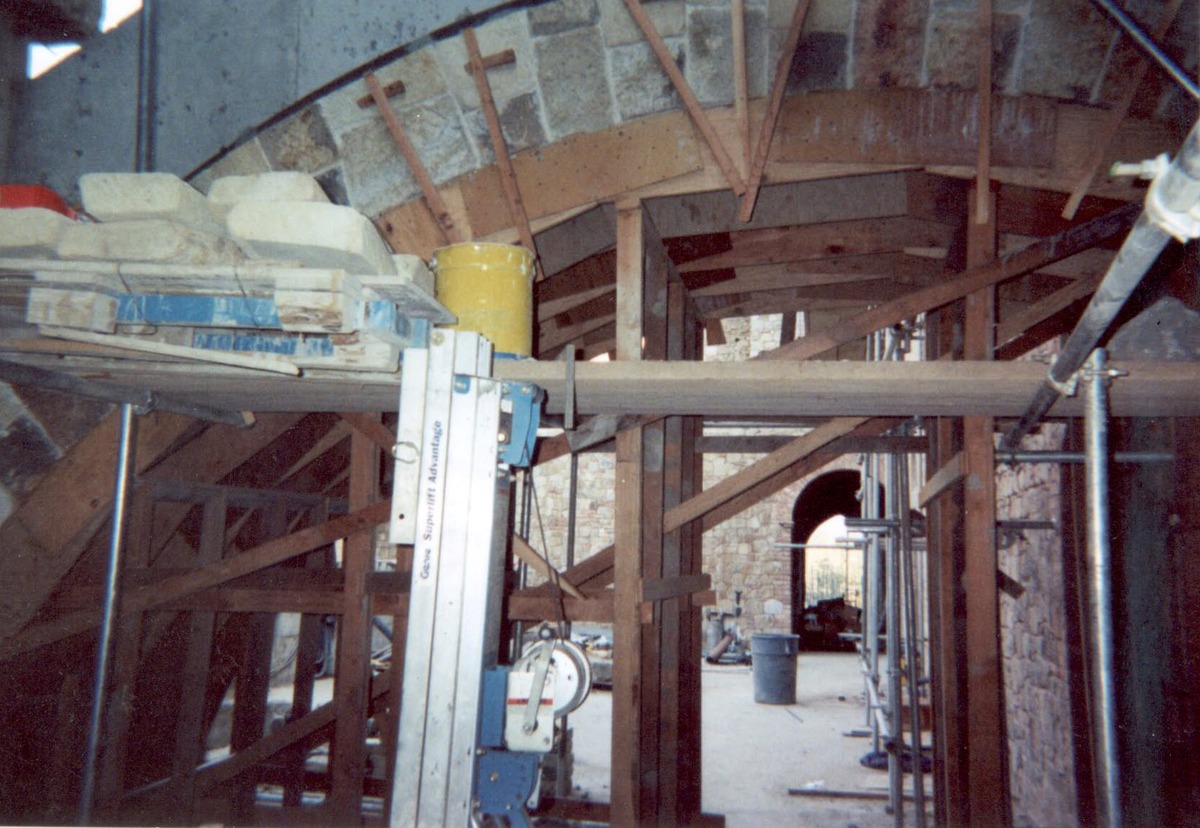
Entrance to the Courtyard from the Crush Pad in 2004.
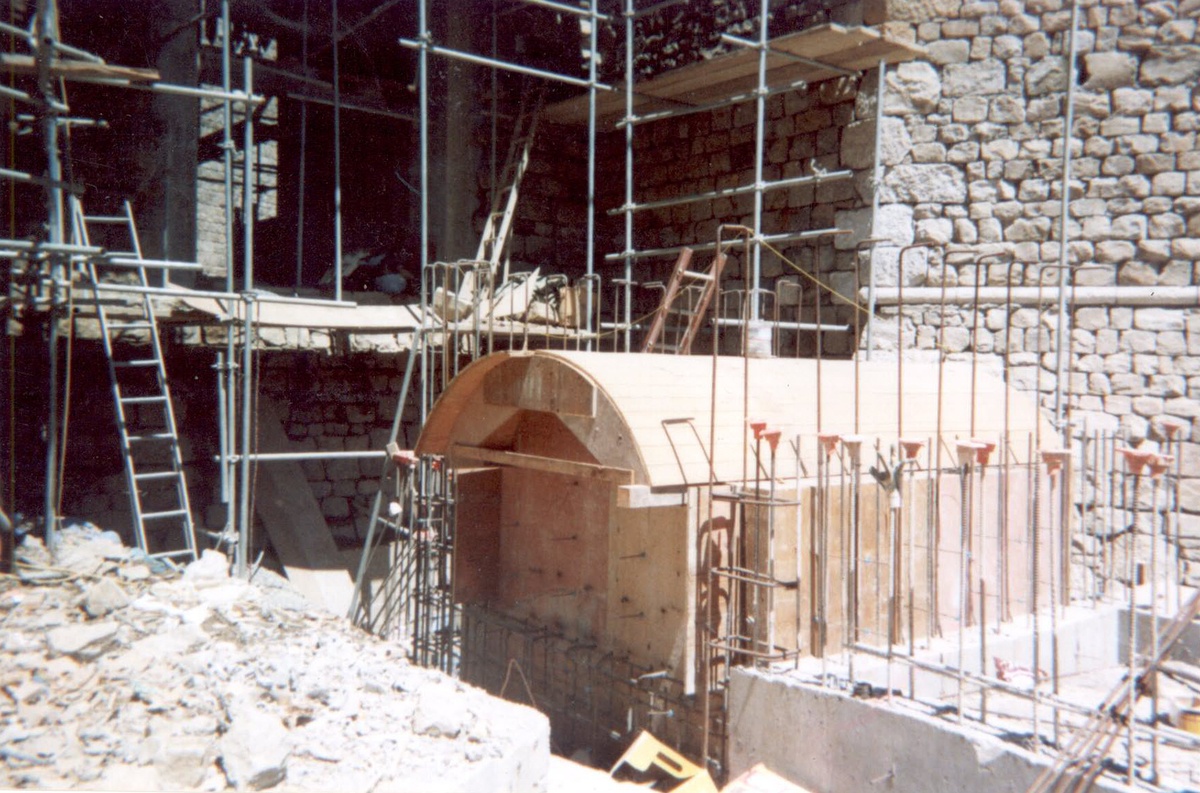
Construction of the Drawbridge steps. The entrance to the Castello can be seen in the upper left. Photo taken in 2003.
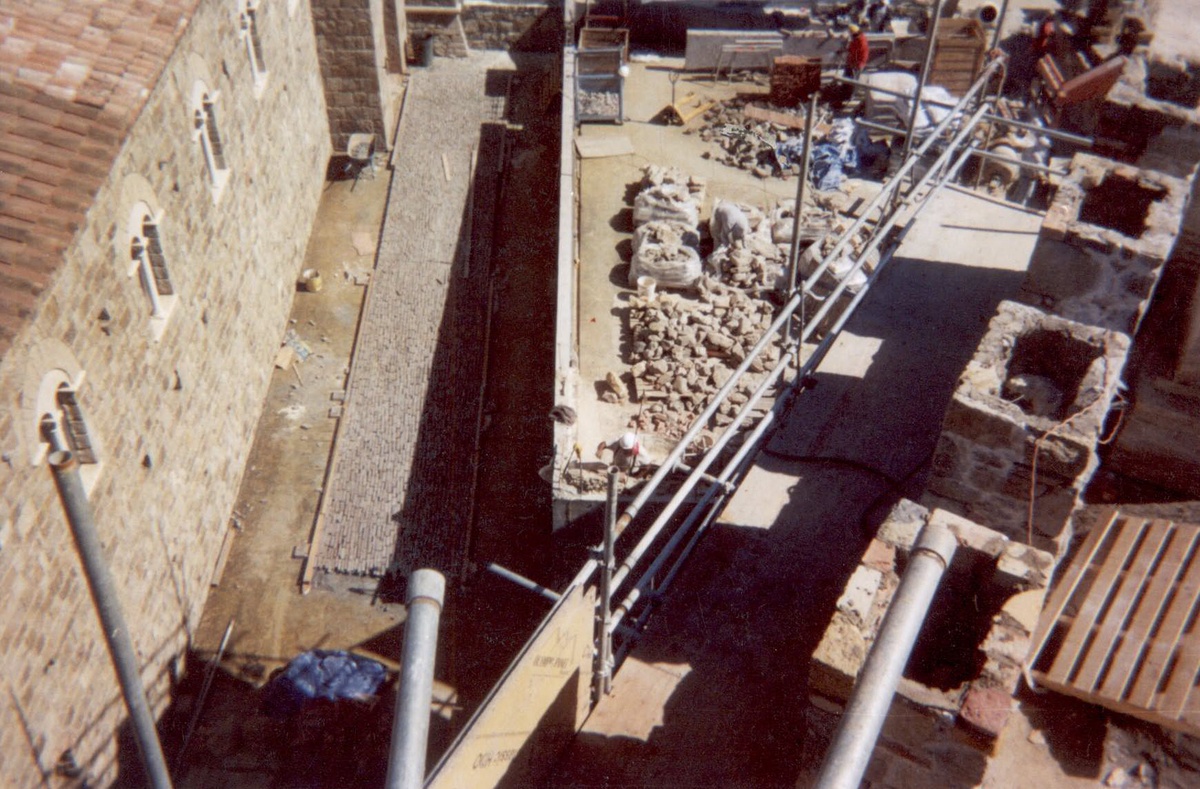
View from the South Tower. Great Hall on the left, Upper Terrace on the right. Walkway to Great Hall in center. Photo taken in 2005.
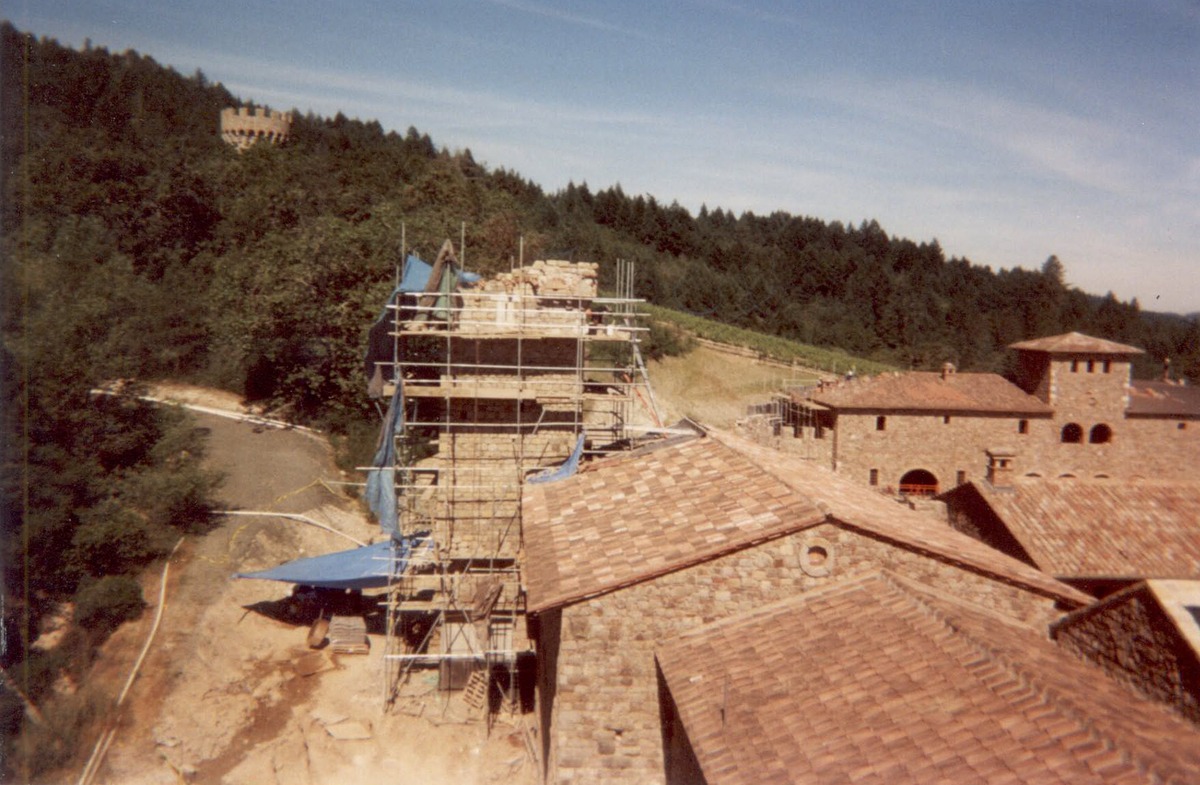
Battle-damaged tower under construction in 2005. Farmhouse (far right) and fermentation rooms taking shape.
Castello di Amorosa appears to be an authentic castle for one reason only: it is an authentic castle, though fancified. We either used construction methods and materials that would have been used 1,000 years ago, or we used very old hand-made materials that had survived up to modern times. A fireplace predating Christopher Columbus adorns the Great Hall, and Iron Maiden from the late Renaissance dominates the torture chamber. A wrought iron dragon from the times of Napoleon hovers over the massive main door. More than 8,000 tons of stone were chiseled, not sawed, by hand to be absolutely authentic. Nearly 200 containers of old, hand made materials were shipped from Europe to lend authenticity.
We spent years sourcing old materials. Where we couldn’t find authentic handmade materials, we created them by using the same methods and materials of long ago. Fritz Gruber supplied me with nearly one million handmade, antique bricks from torn-down Hapsburg palaces. Georgio Mariani of Assisi in Umbria, along with his father, brother and uncle, made all lamps, iron gates and decorative iron pieces by hand over an open forge. Every nail, every chain link, every hinge and lock was hand-done by the Marianis. Their friend, Lucio, made all the leaded glass windows by hand. The Nanni brothers hand-carved all the ceiling beams. Loris Vanni and his brother-in-law Marino hand carved most of the door and window surrounds and the well. Dario Ruffini hand-carved the stone crests depicting my family’s coat of arms. There were many others, mostly from Italy, too numerous to name, who lent a hand to create the only real medieval castle in the United States. Even an Italian architect specializing in the restoration of medieval buildings, Frederico Franci, lent advice.
There were problems, from containers full of materials not arriving on time to the County making us re-grout virtually all the walkways and rebuild all the stairs, as they didn’t quite comply with local codes.
I kept declaring larger dividends than I normally would have from V. Sattui to keep afloat. But finally, in late 2005, I ran out of money. Enter Wells Fargo Bank– from which I secured a large loan. By mid-2006, I was nearly in a panic about going bankrupt and losing my entire property. I simply couldn’t continue to expend large sums of money I had invested in the Castle, the winery equipment, the vineyards and the wine inventory. It had been nearly 14 years without one penny back. I started selling some of the Castle wine cheaply just to raise money. I borrowed from V. Sattui as well as the bank. I was desperate.
Just as with the Castle, I had endeavored to make no compromises with the wines. We planted vineyards in 1994 through 1996. Yet we waited to make the wines until we had older vines to produce the highest quality.
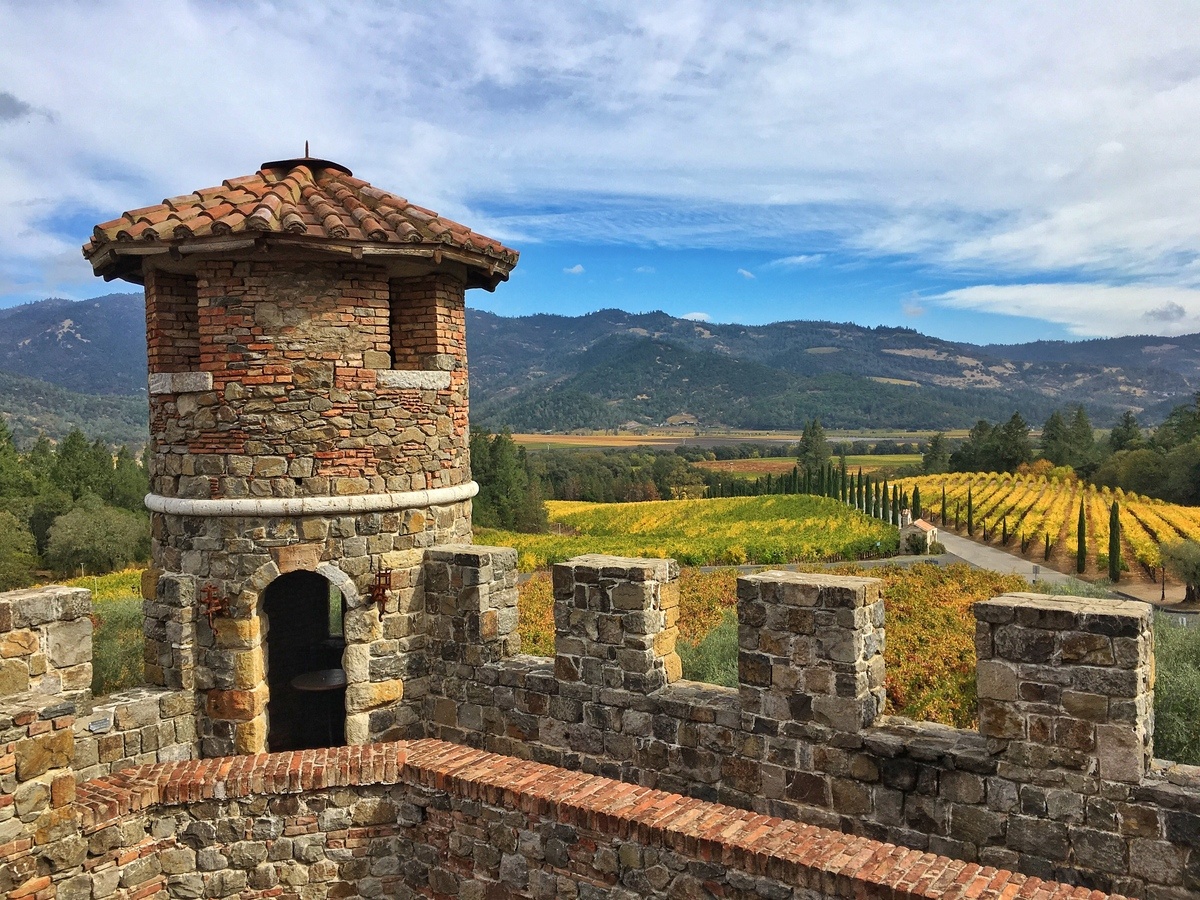
Today Castello di Amorosa produces some of the best wines in the world from its Diamond Mountain District vineyards surrounding the Castello. (Photo: Alison Hernandez 2017)
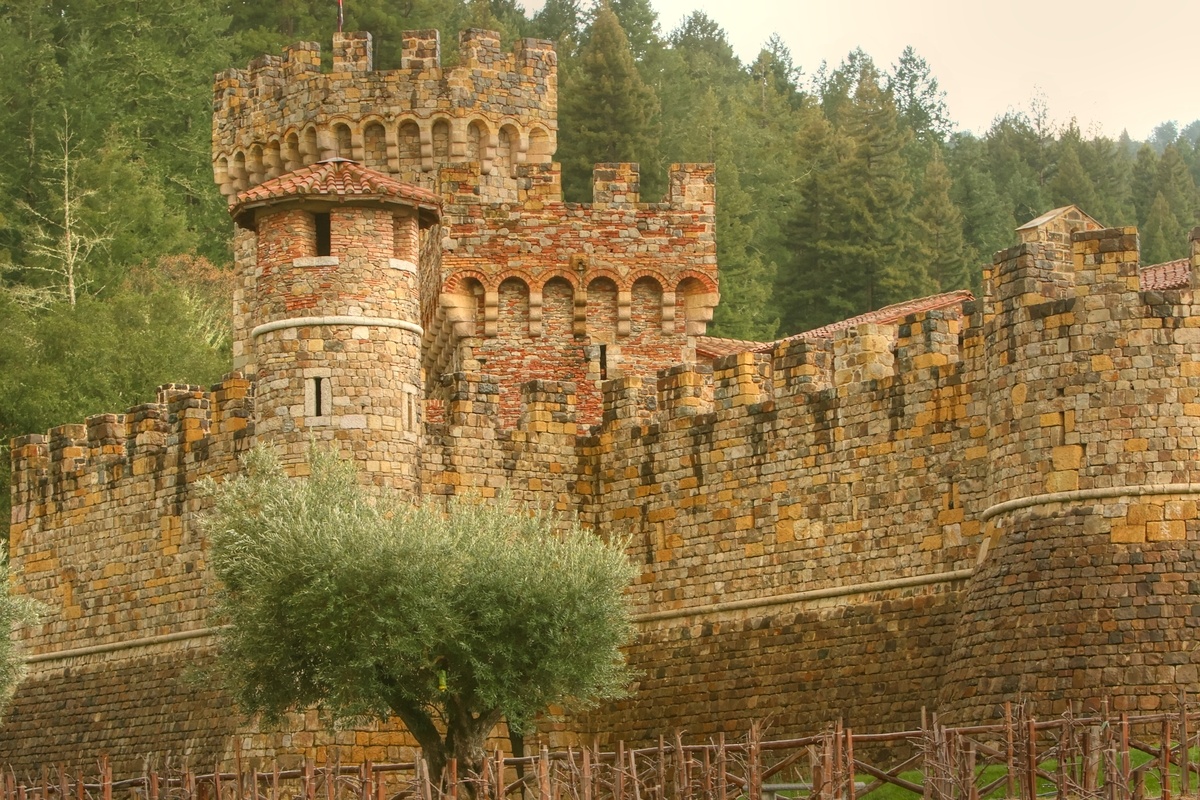
Ramparts, towers, the guard tower and a variety of Castle defensive positions overlook the Cabernet Sauvignon, Merlot, Sangiovese and Primitivo vineyards. (Photo: Jim Sullivan 2010)
Finally, we were able to open on April 7, 2007. I had no idea if the project would be well-received or not. Would I be laughed at or would people respond positively? The first few days after opening gave me hope. The response to both the Castle and our wines was overwhelmingly positive.
Read more about the story of Castello di Amorosa in Dario Sattui’s book, Castello di Amorosa: A Labor of Love
